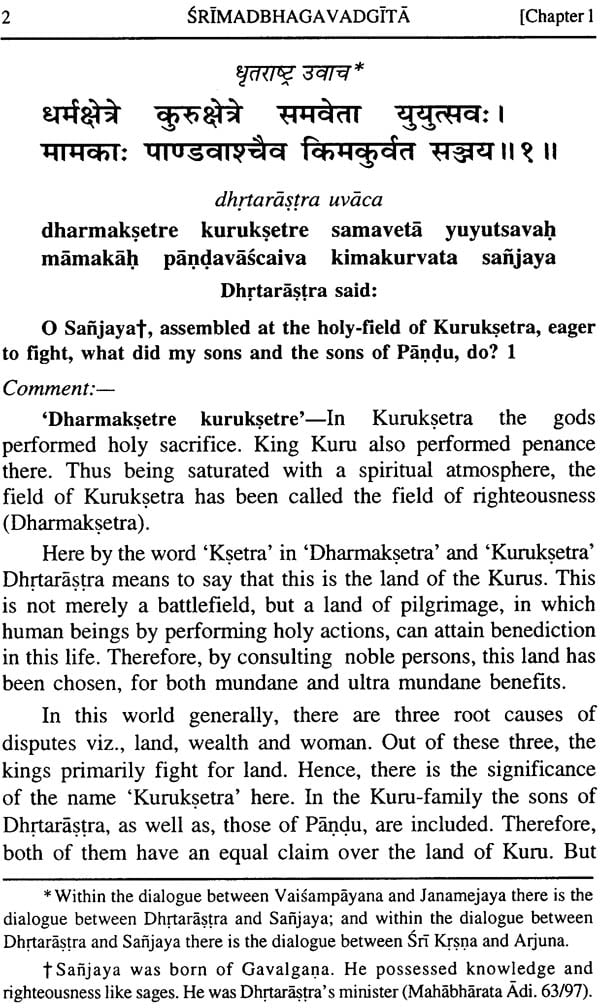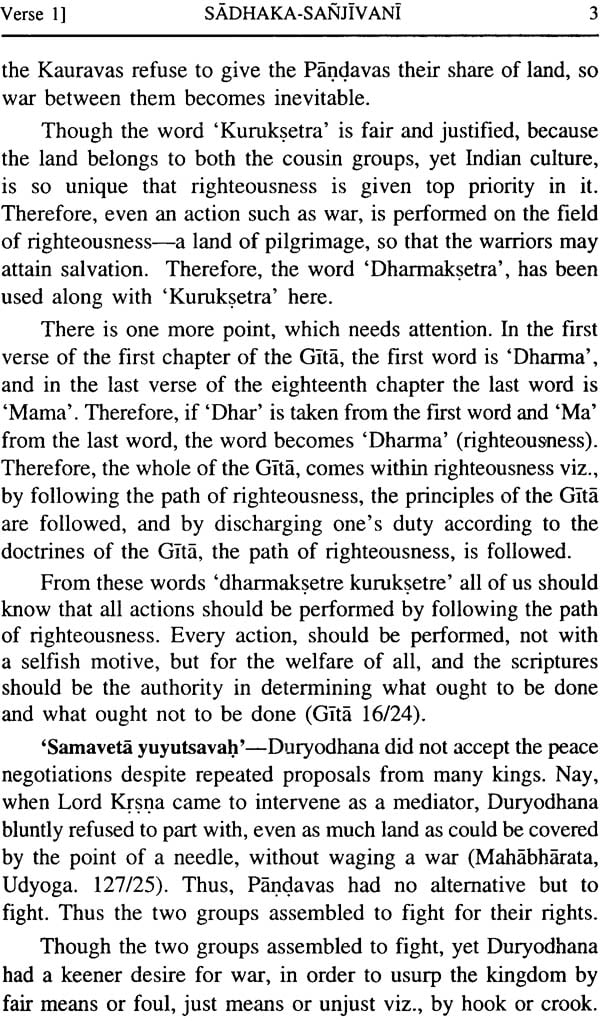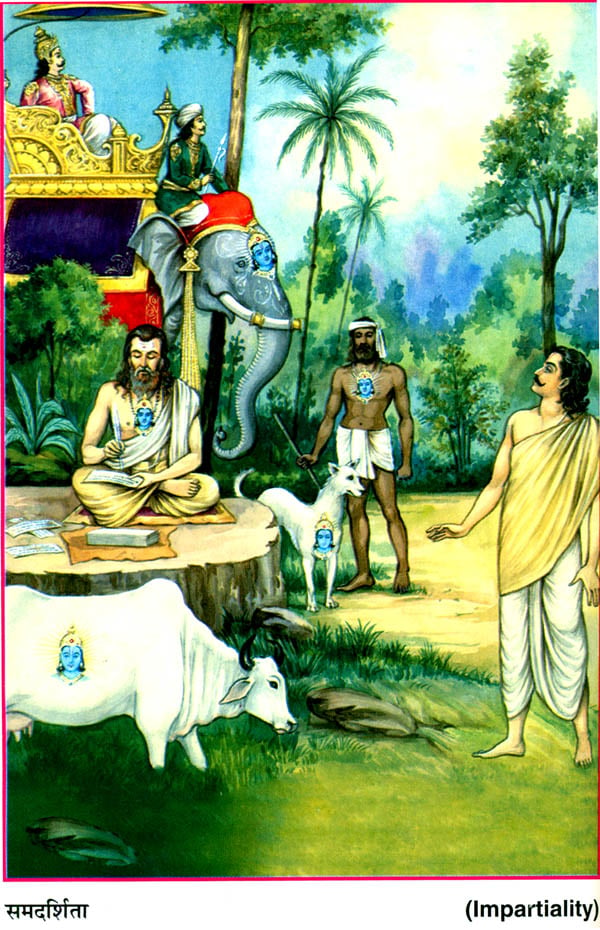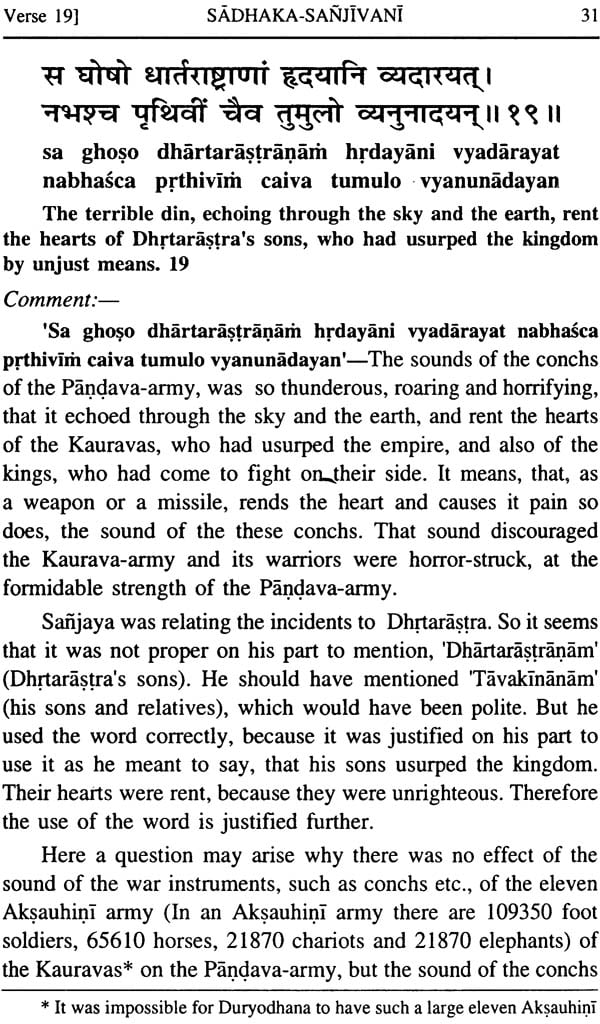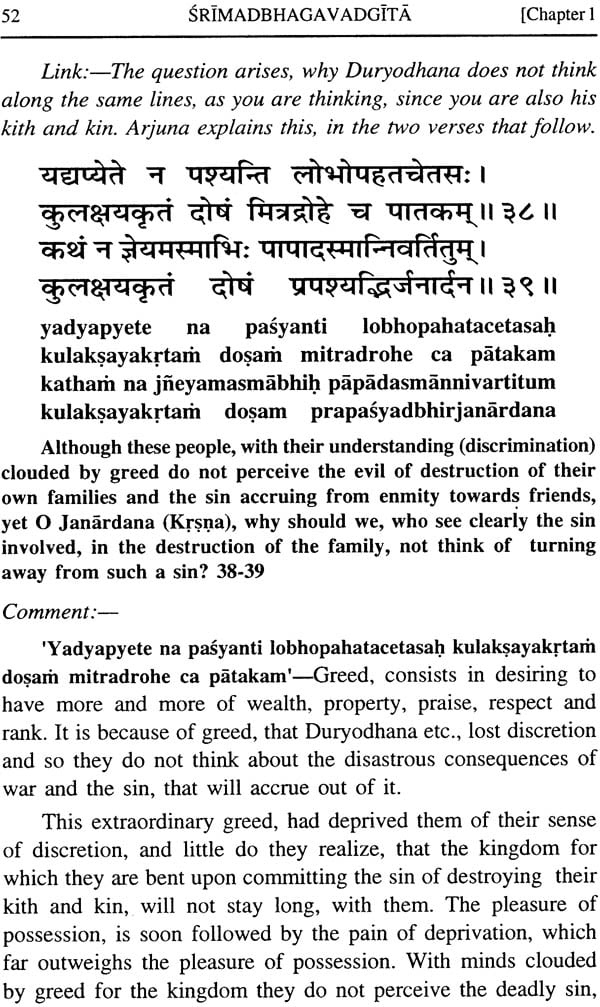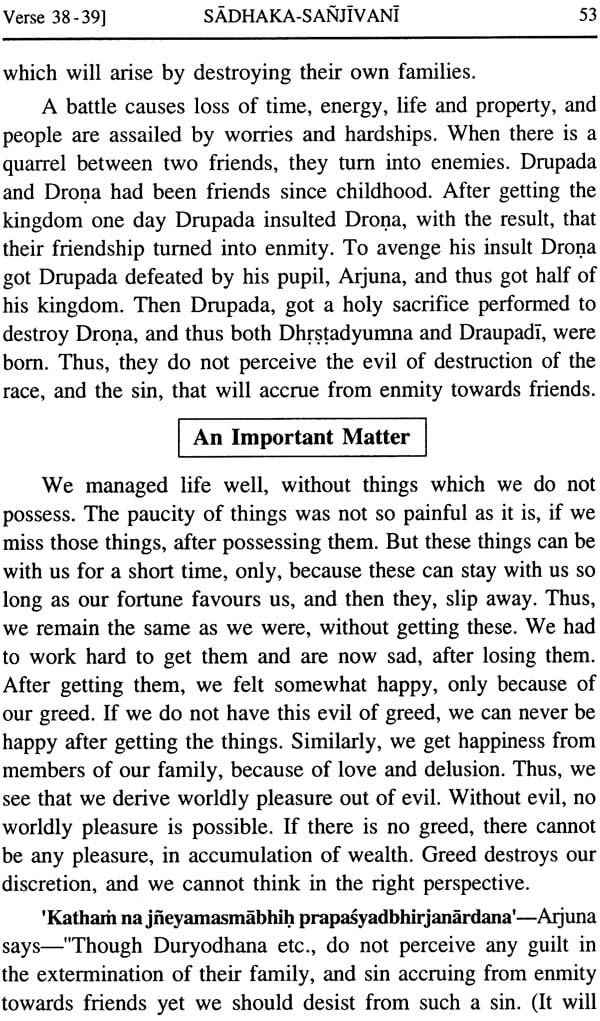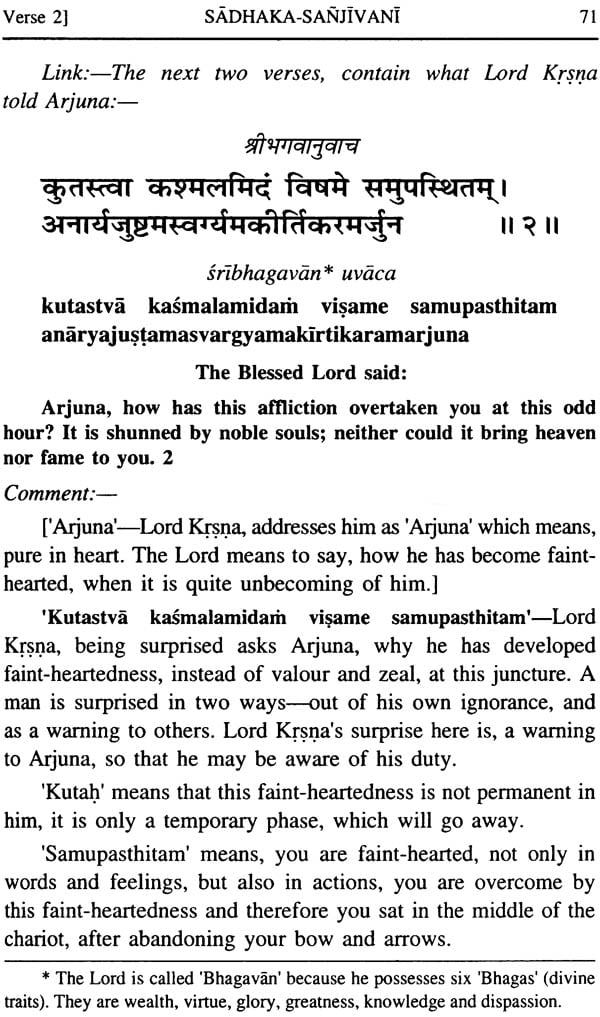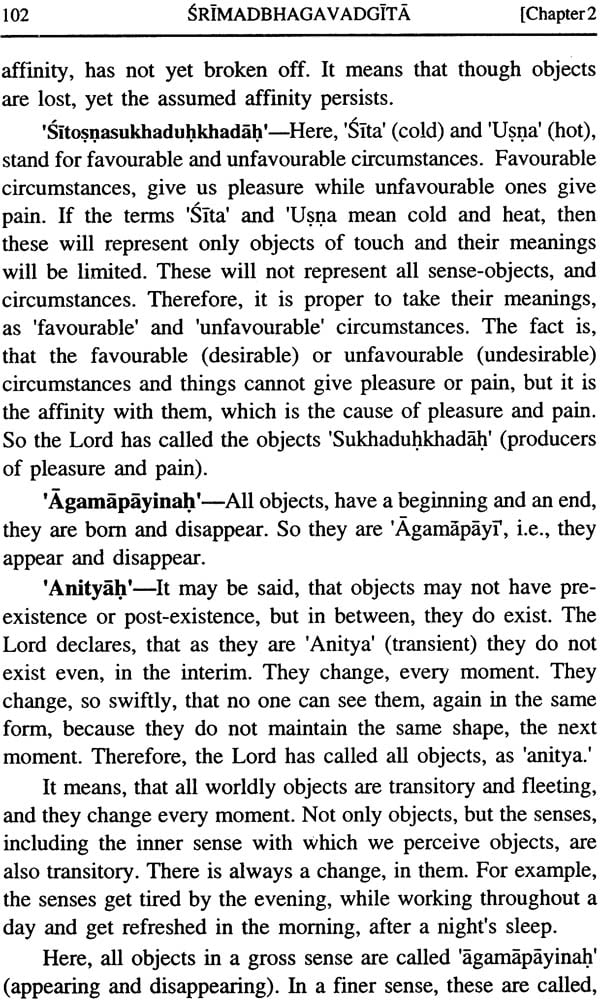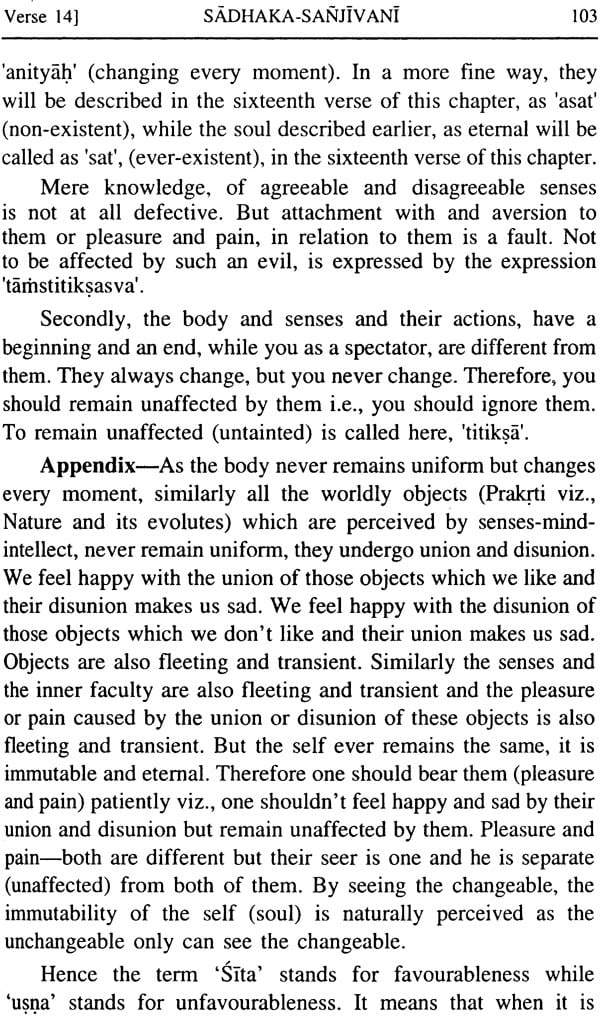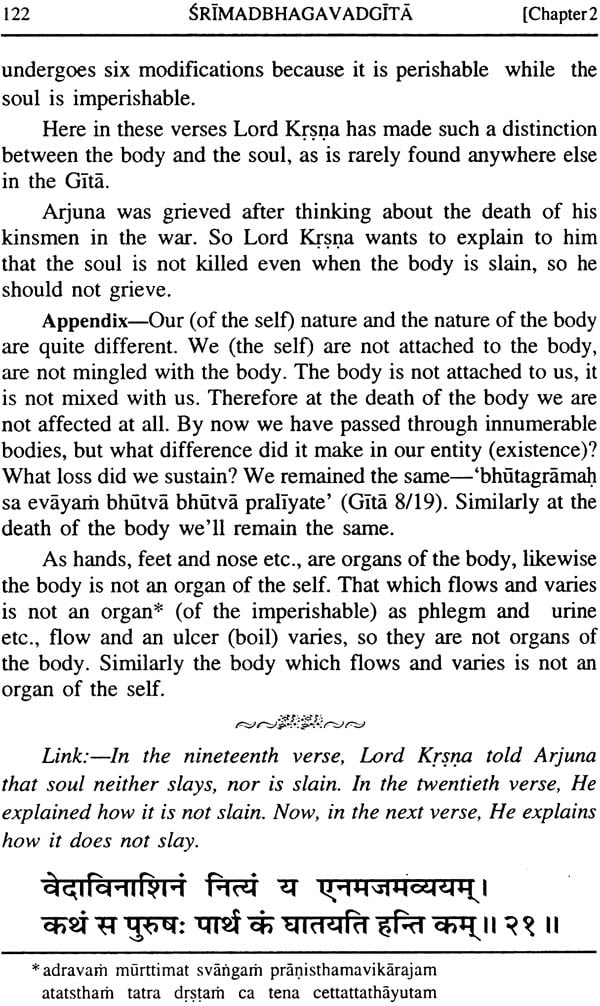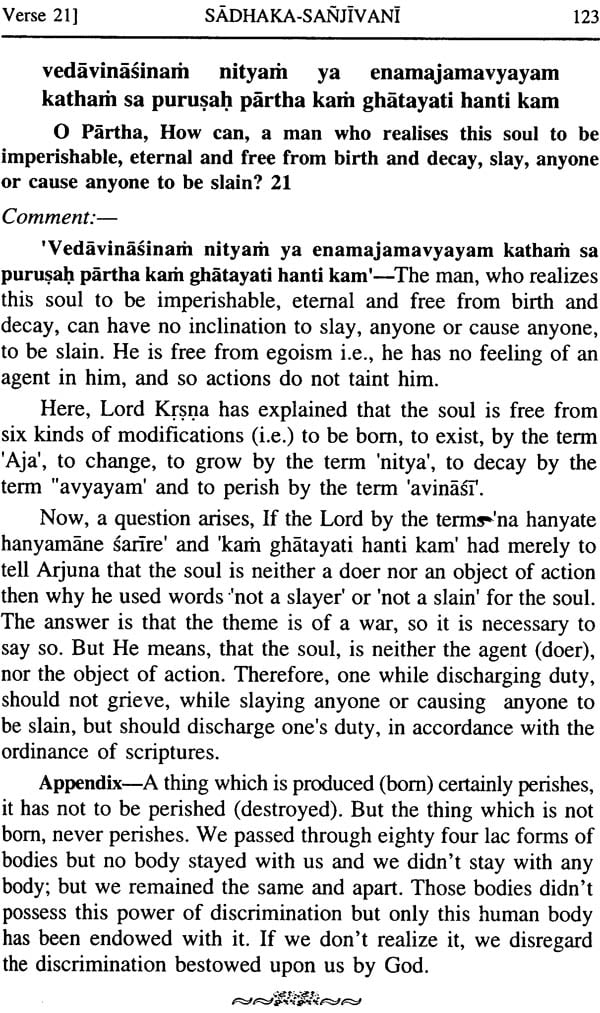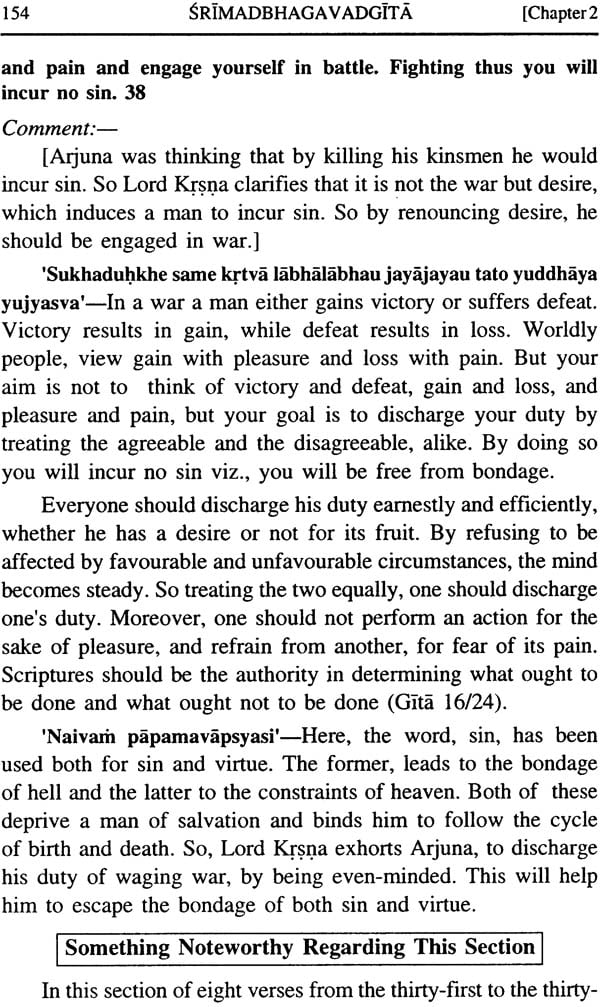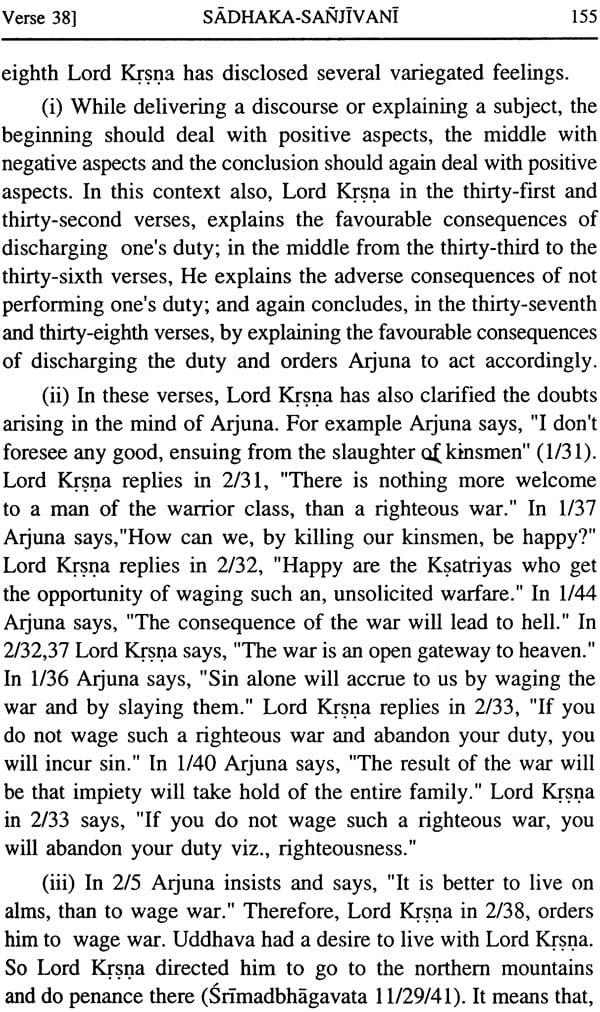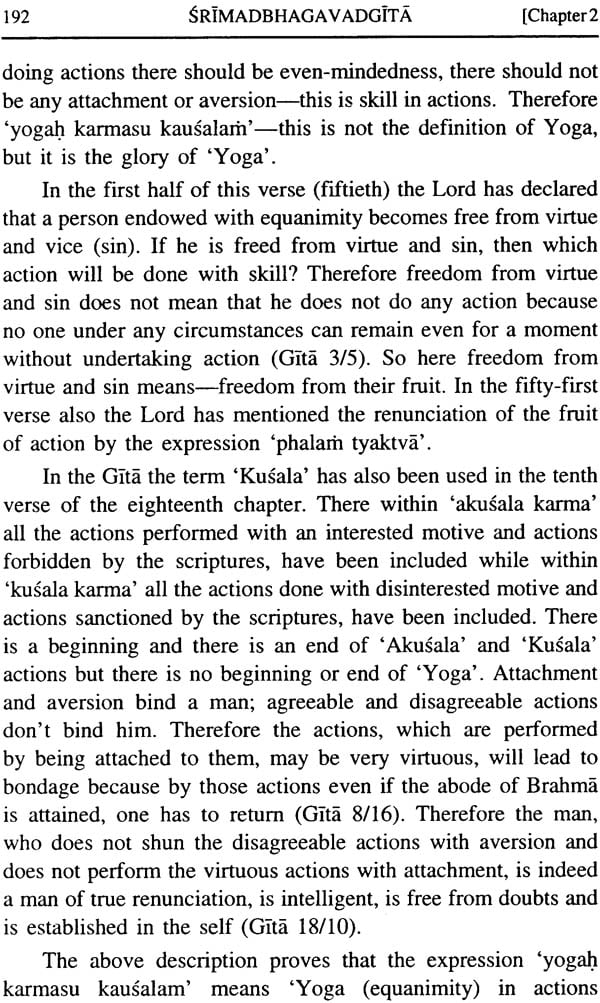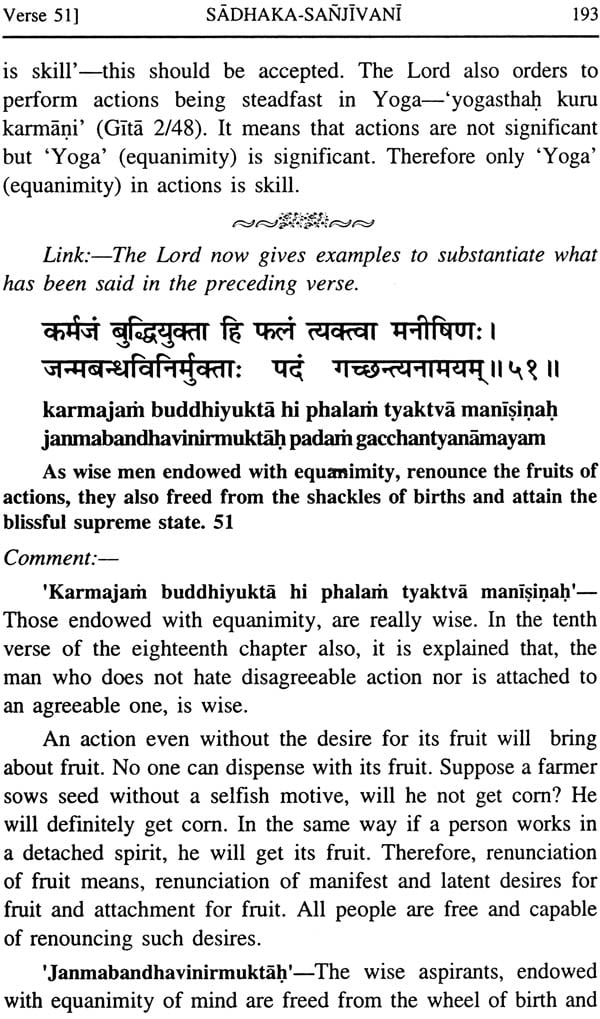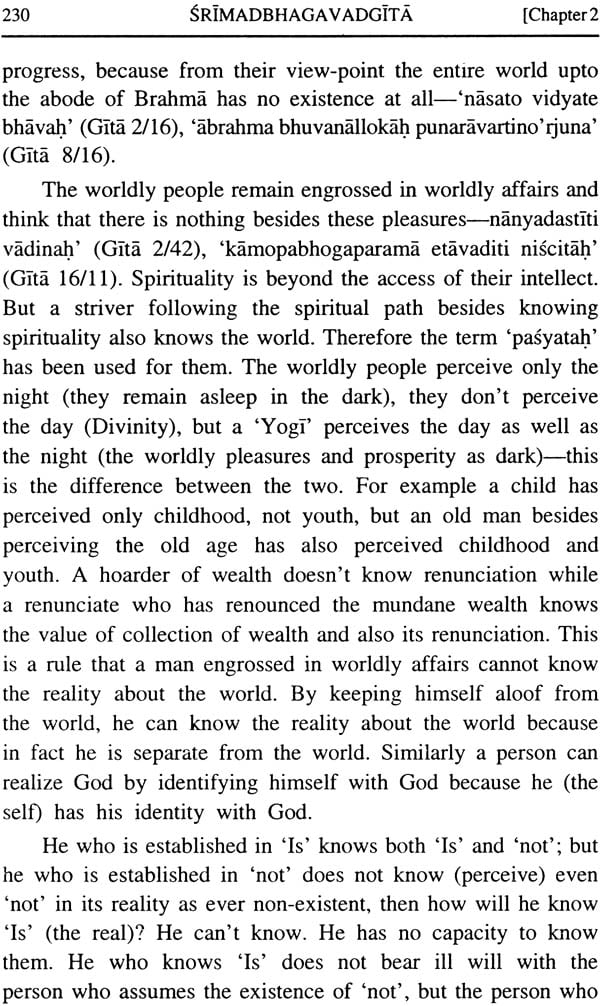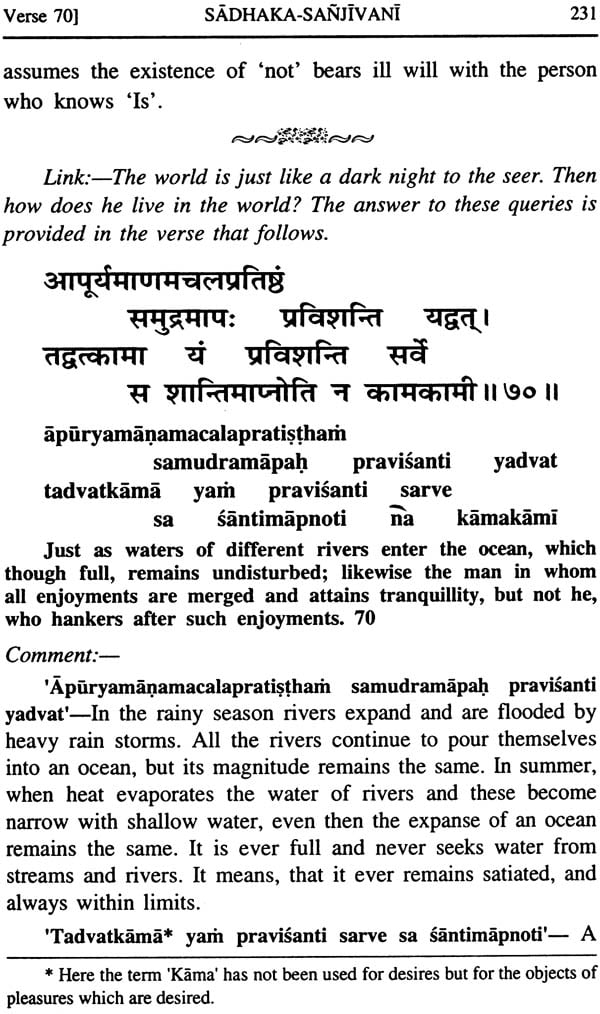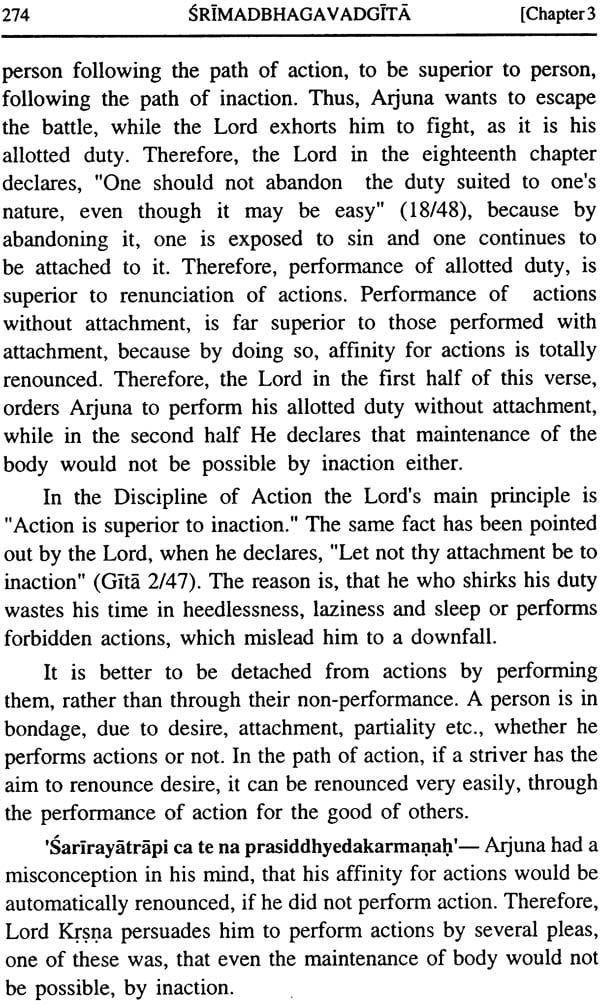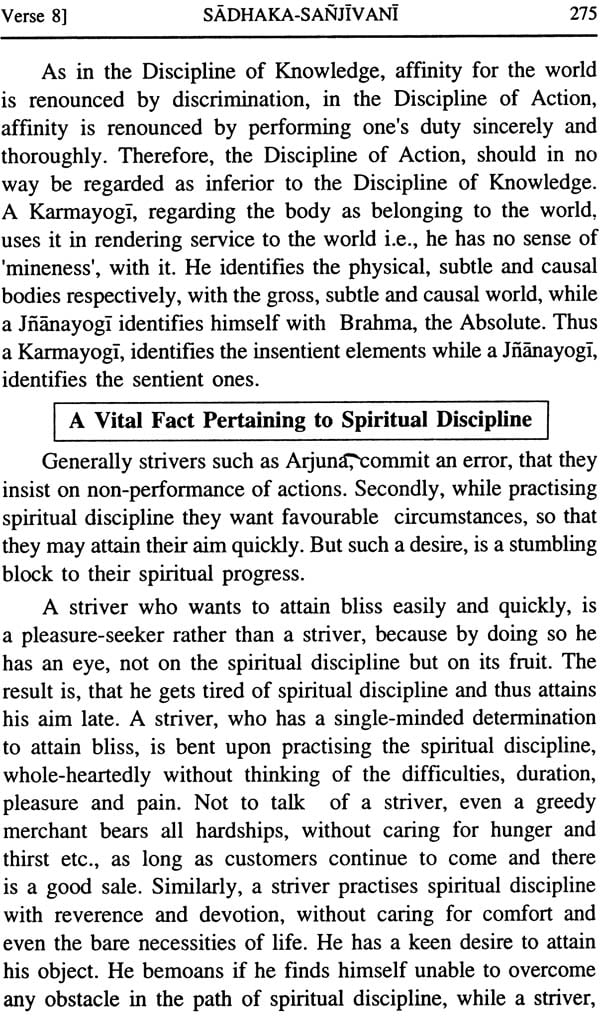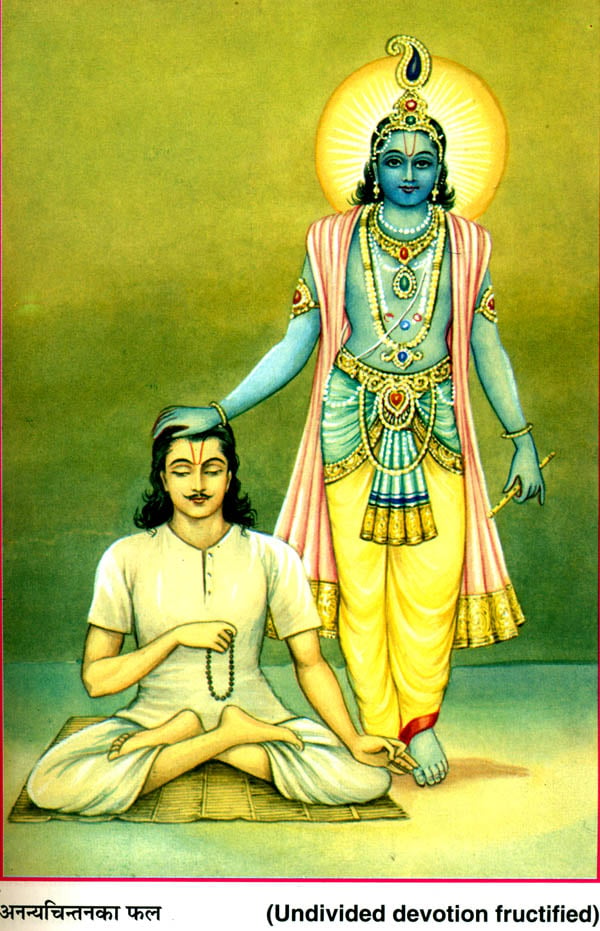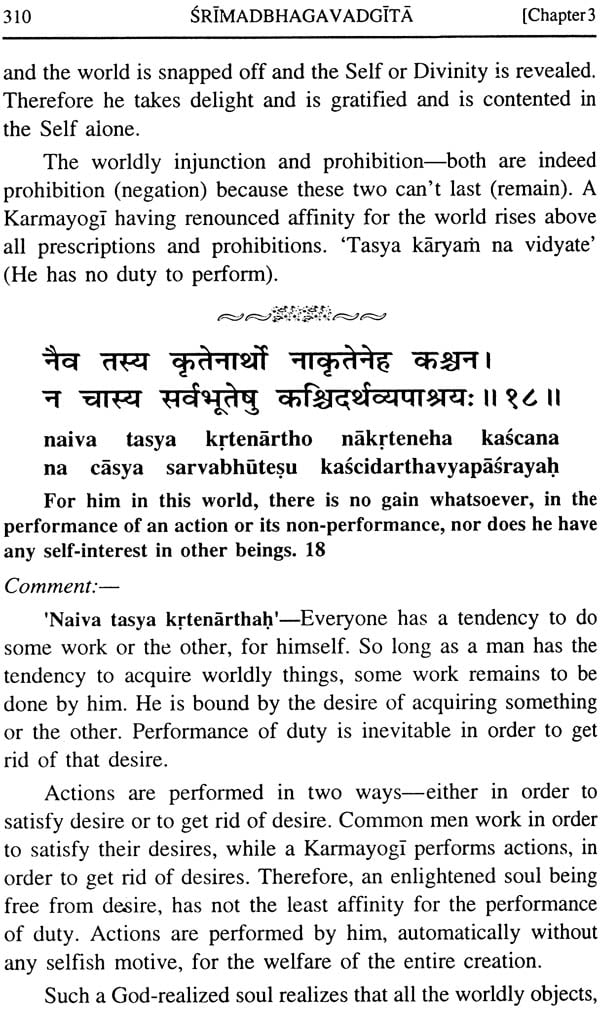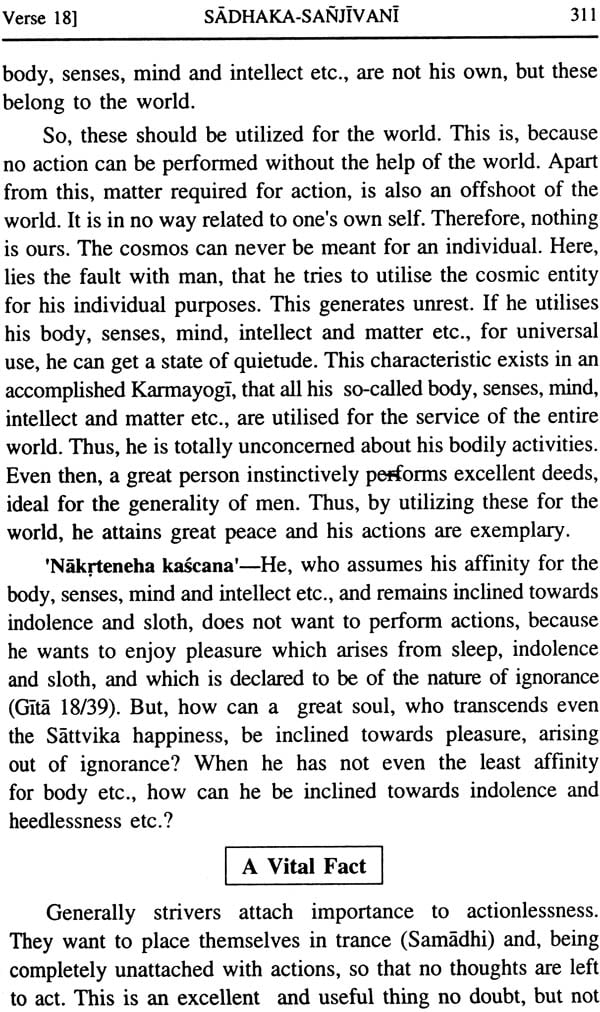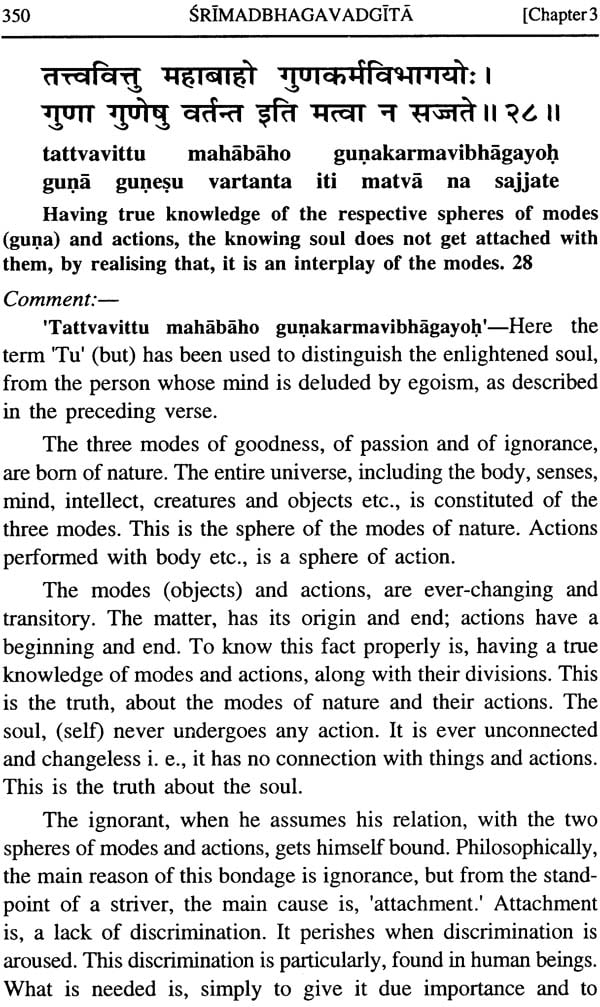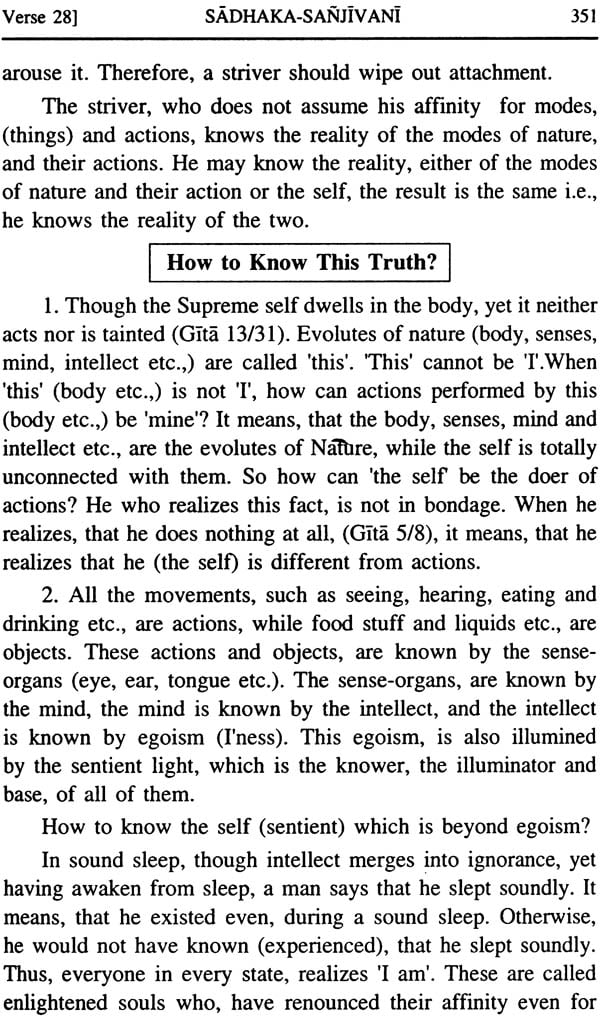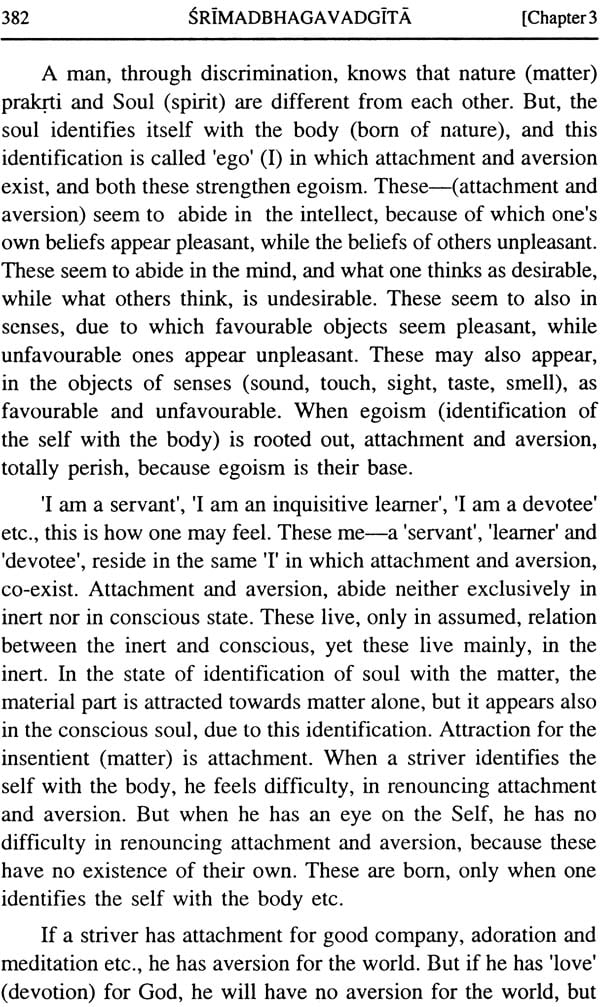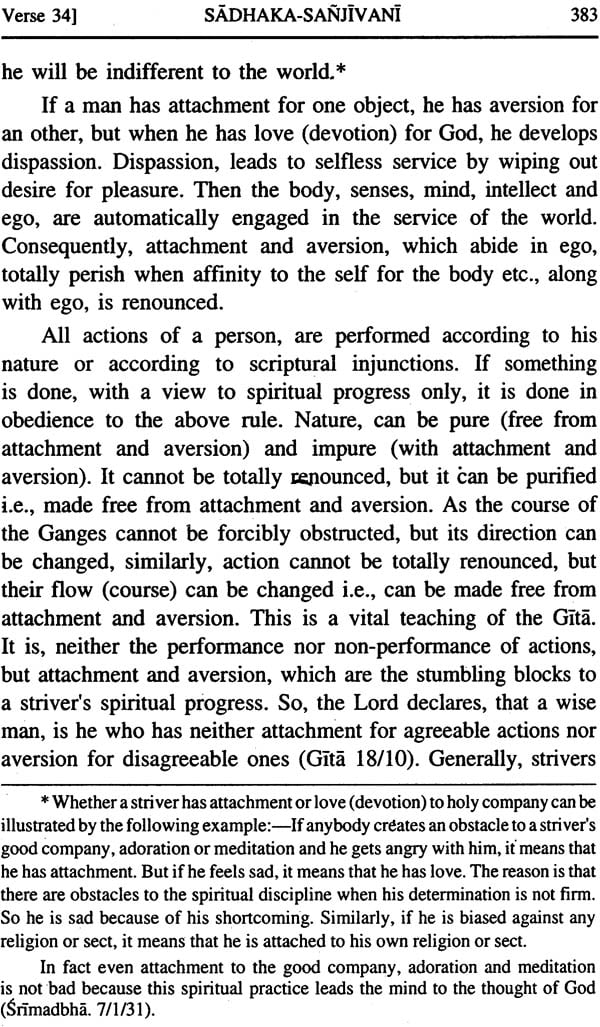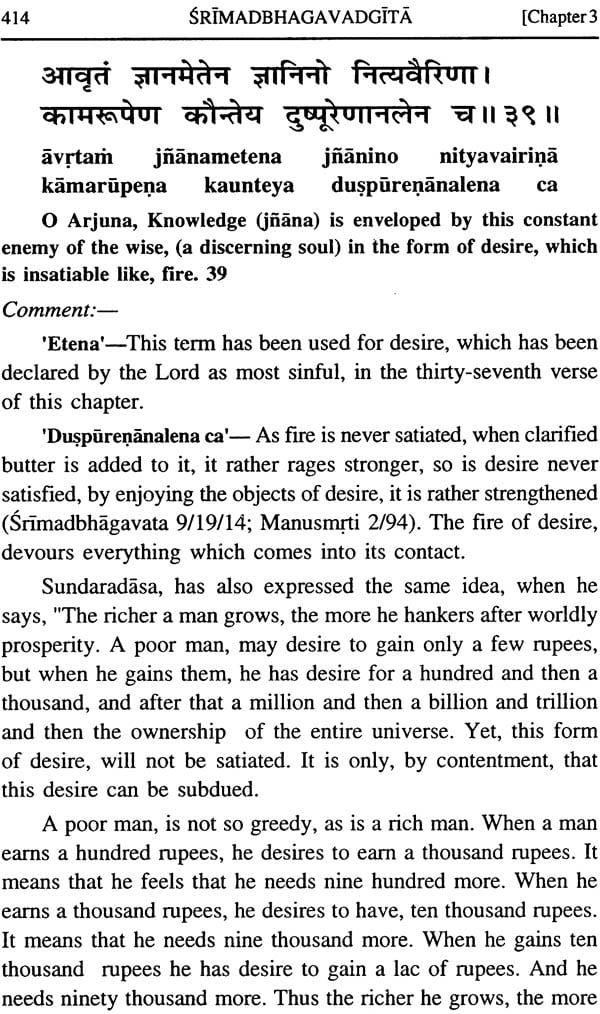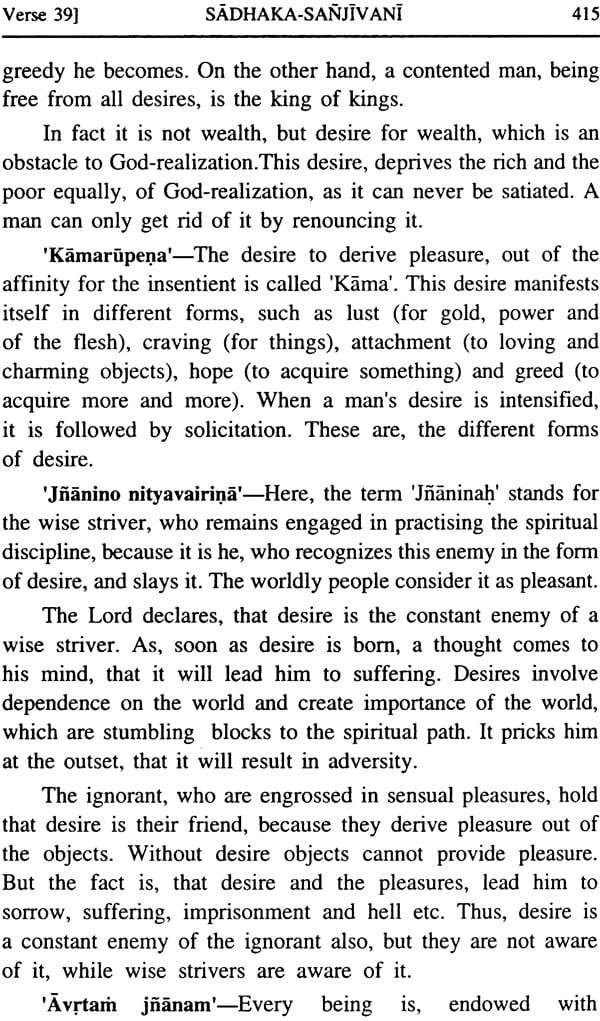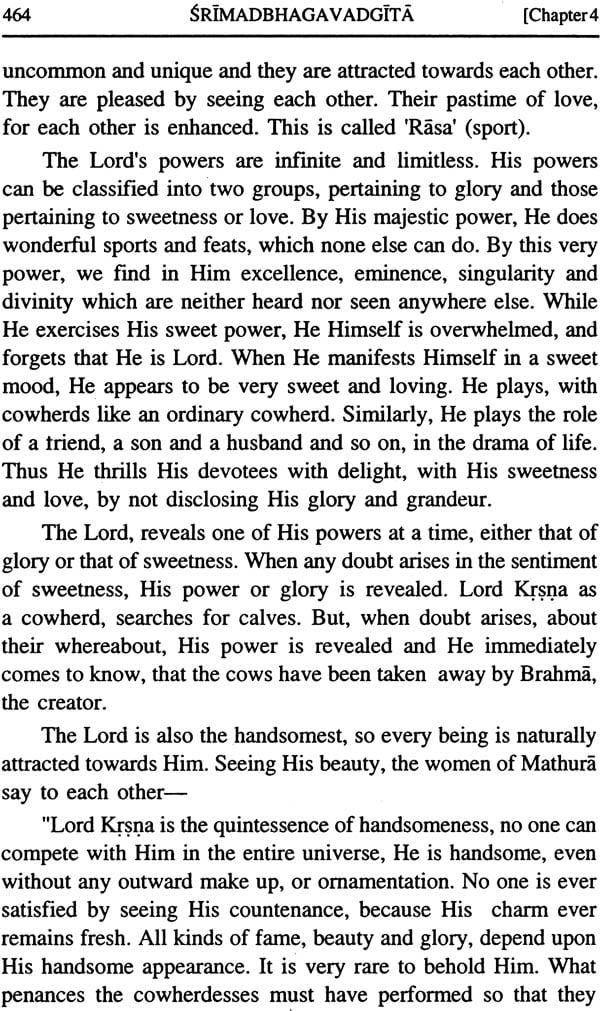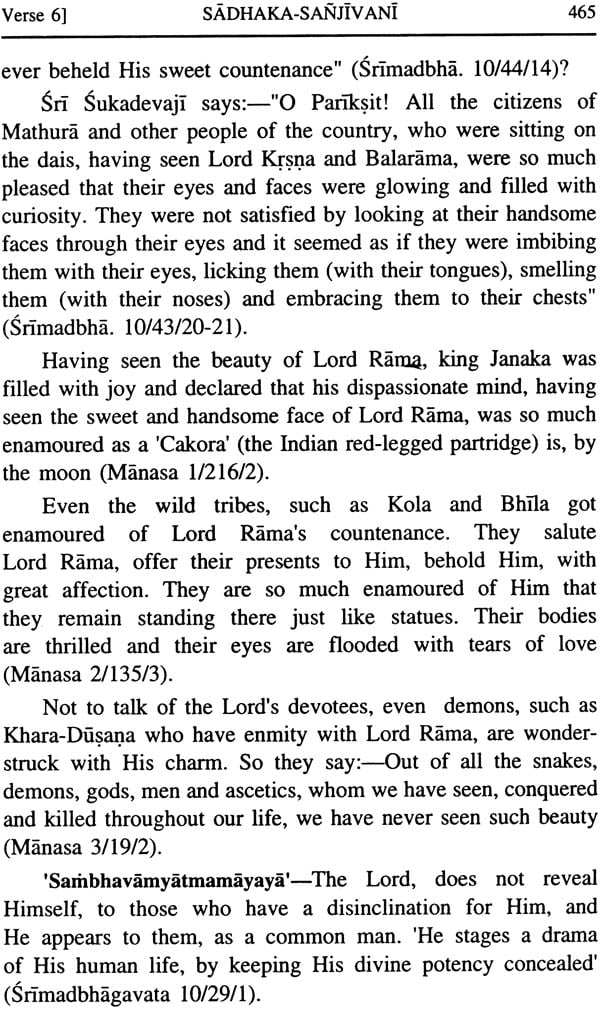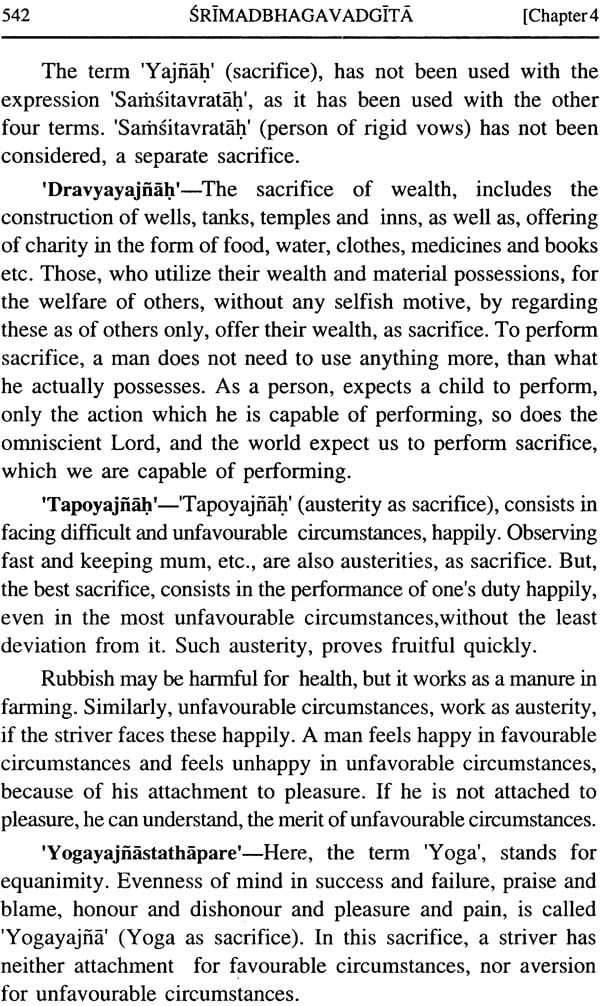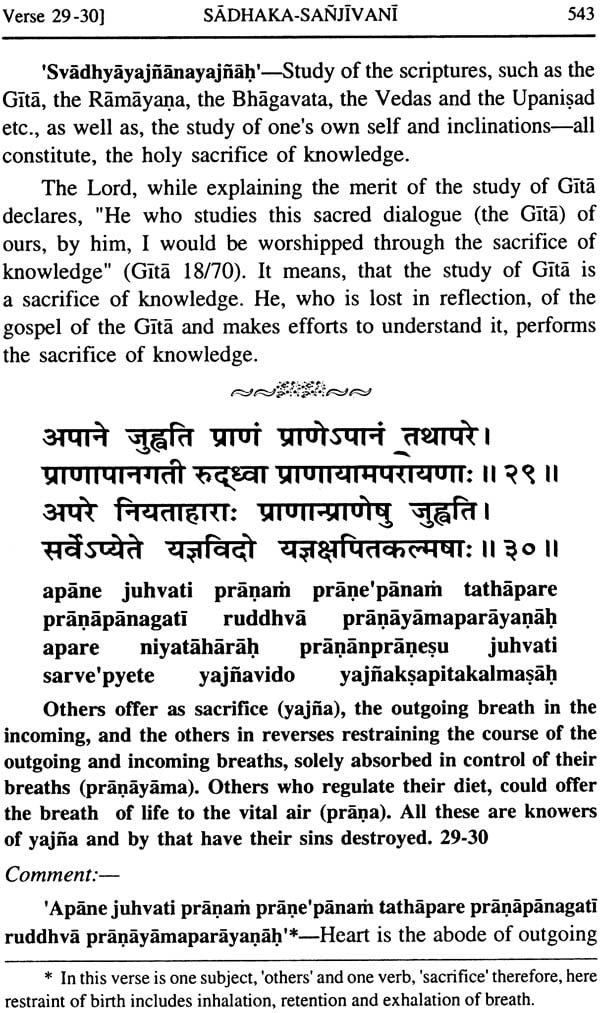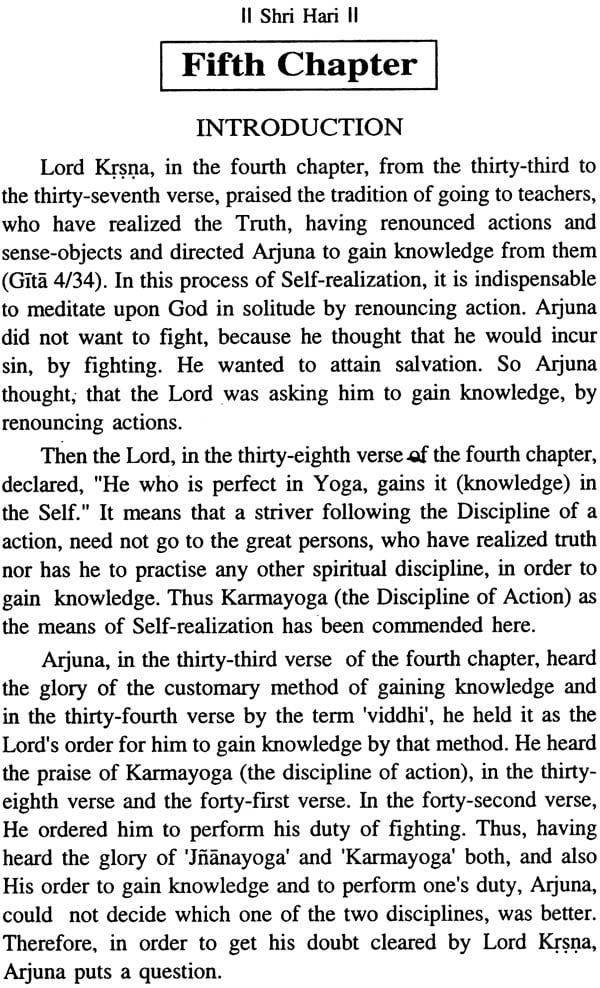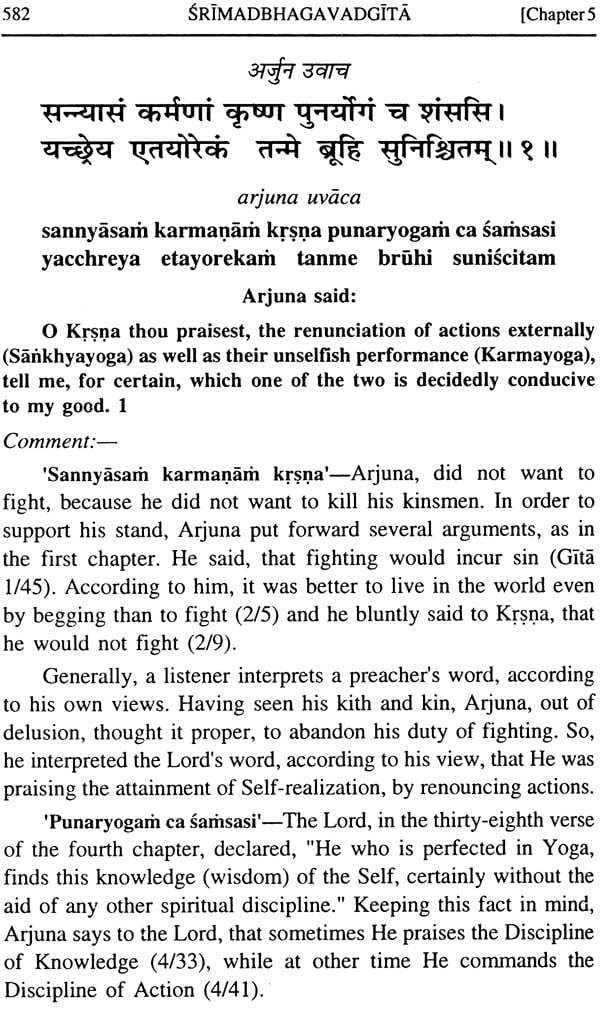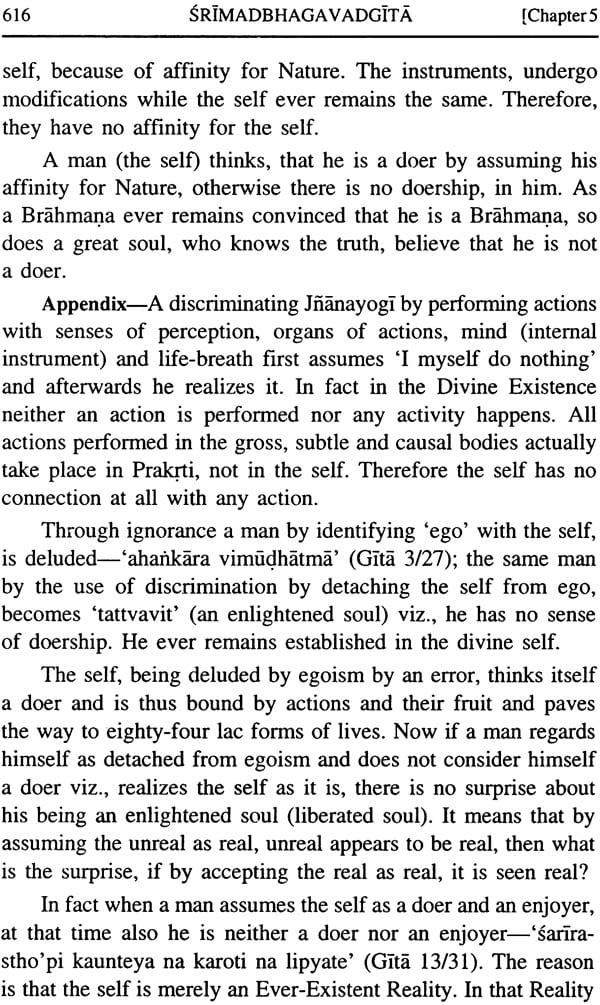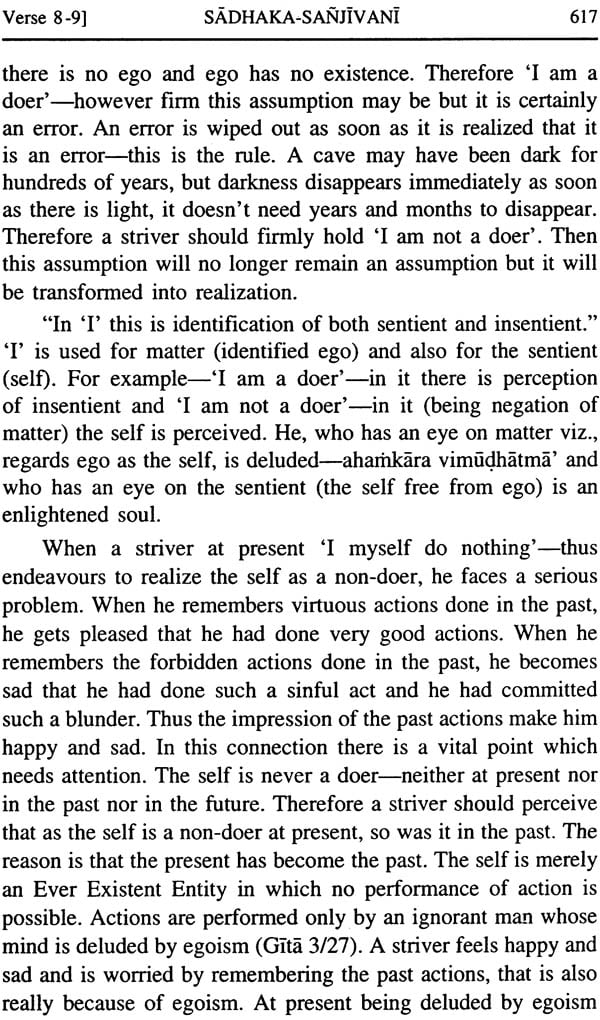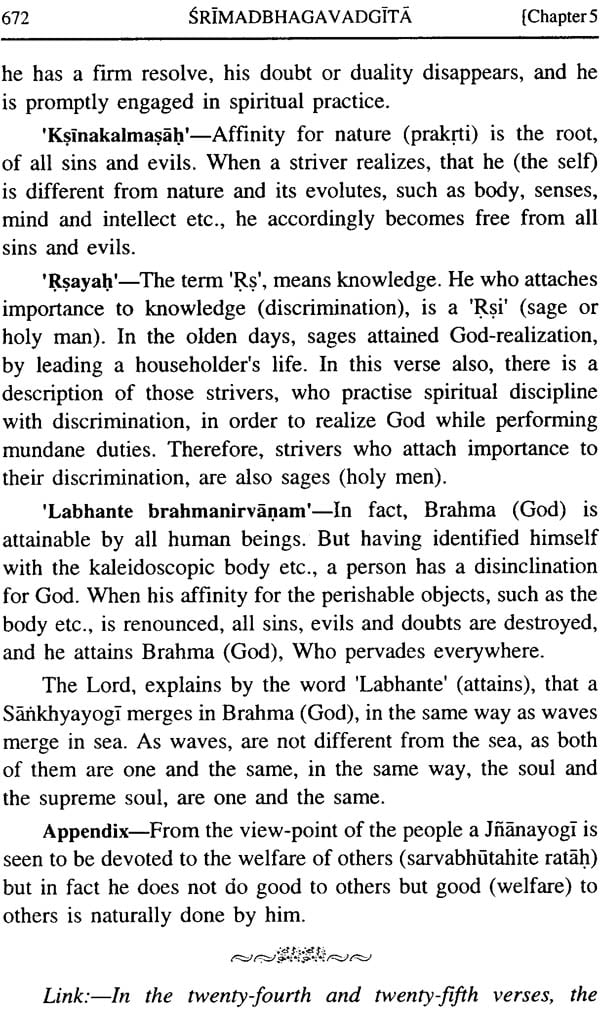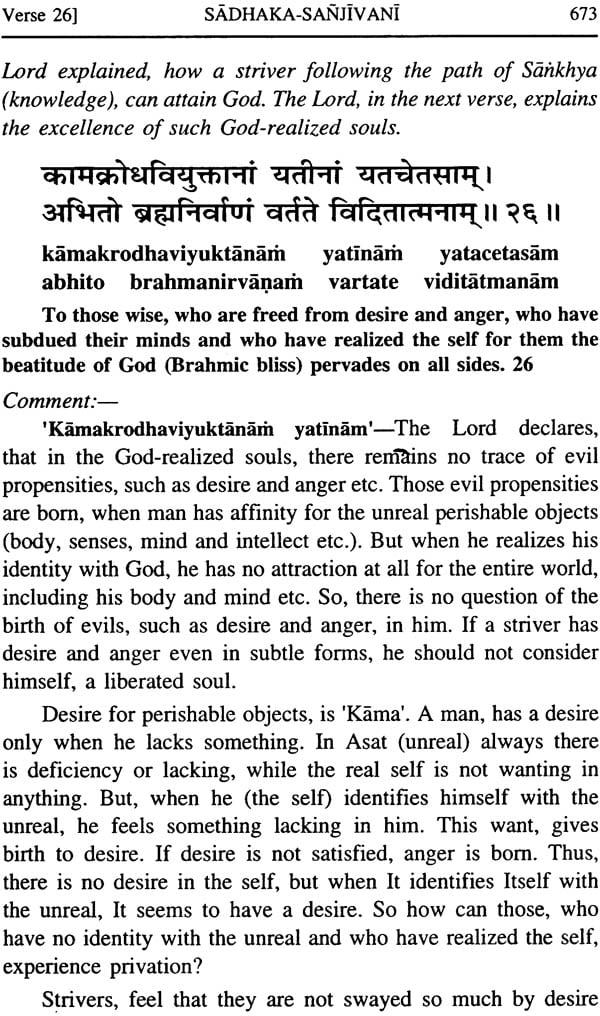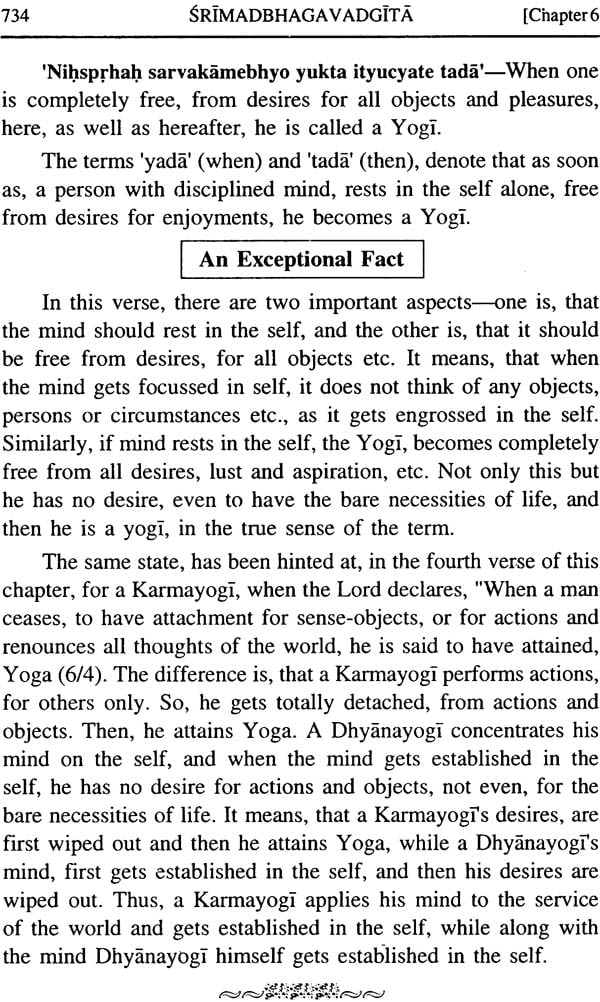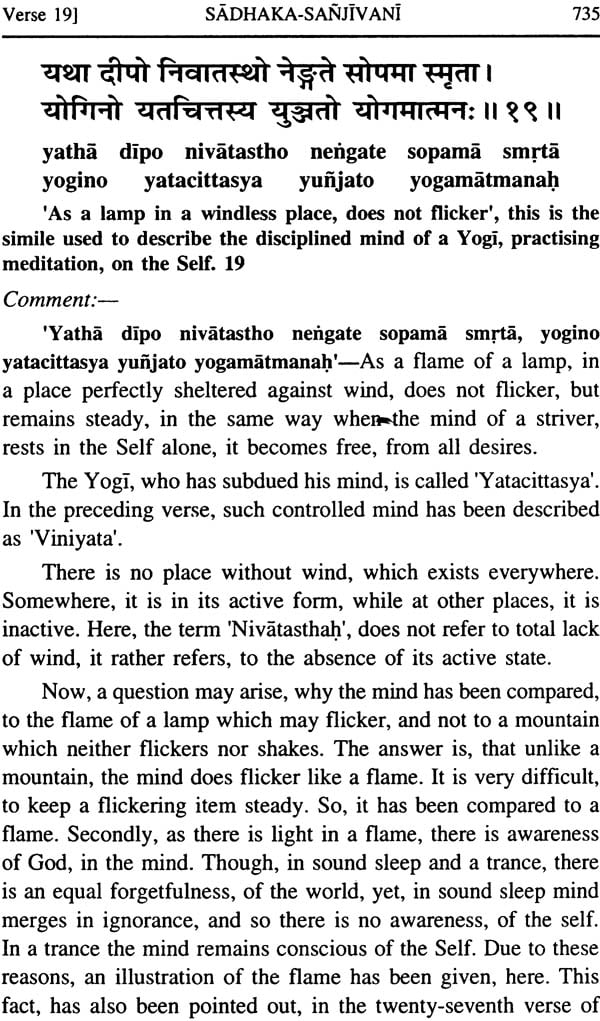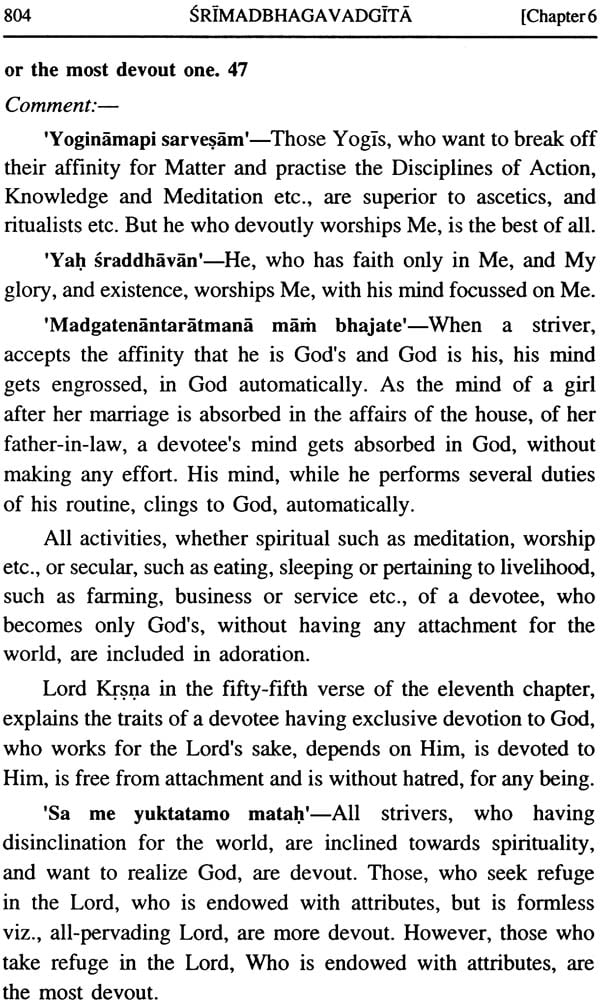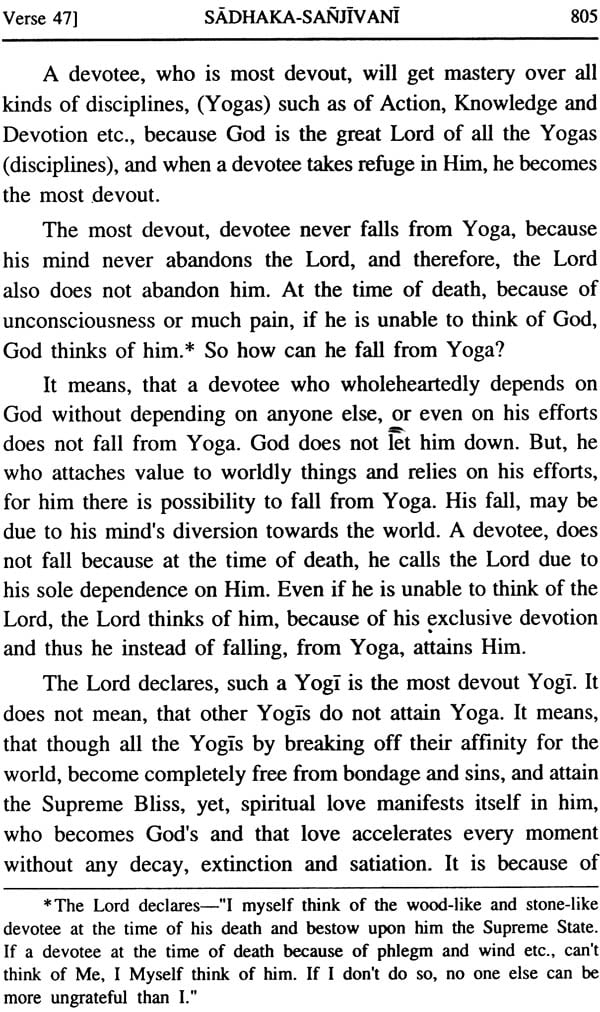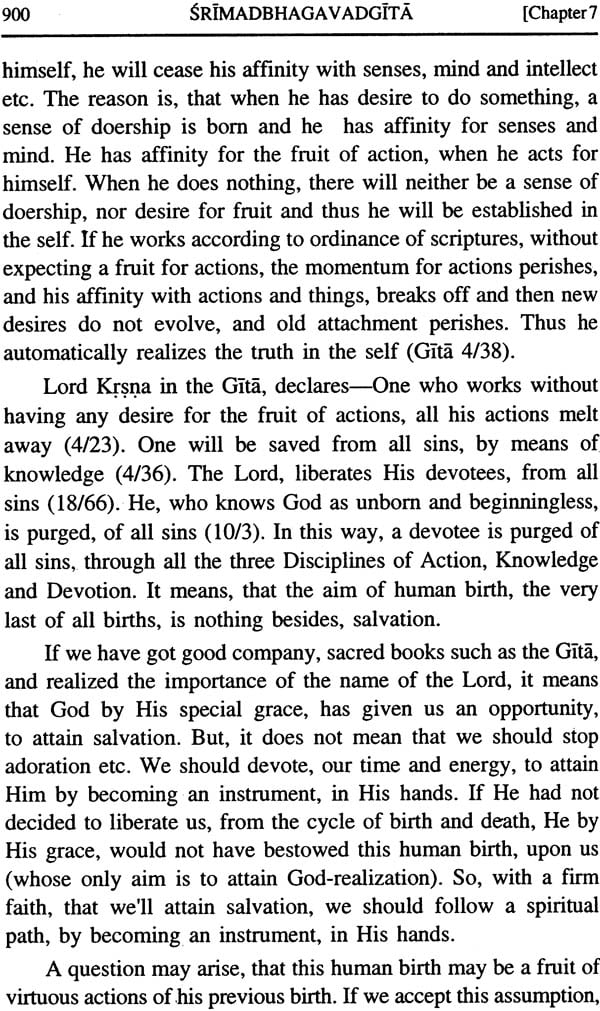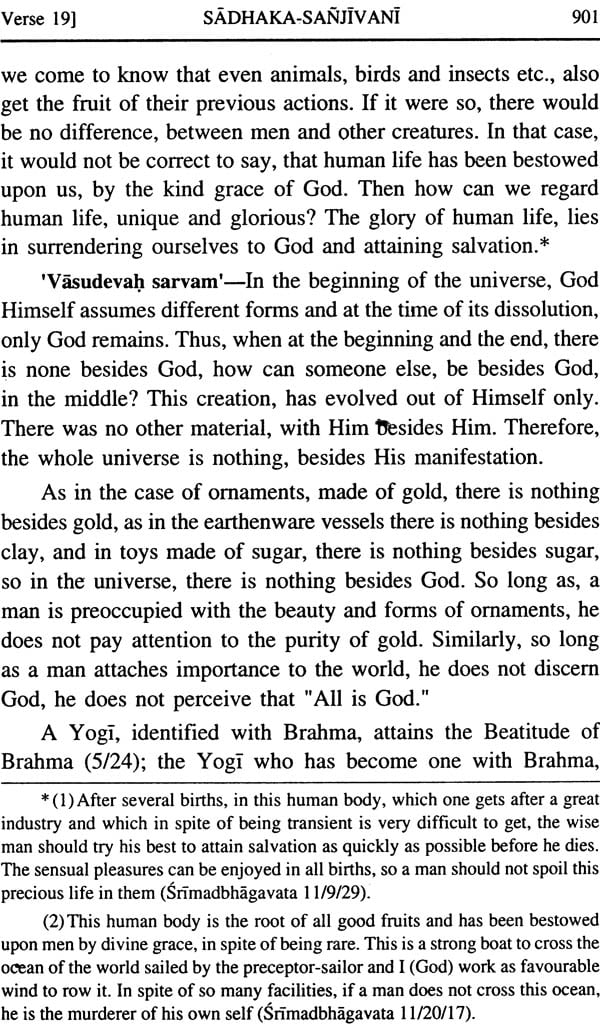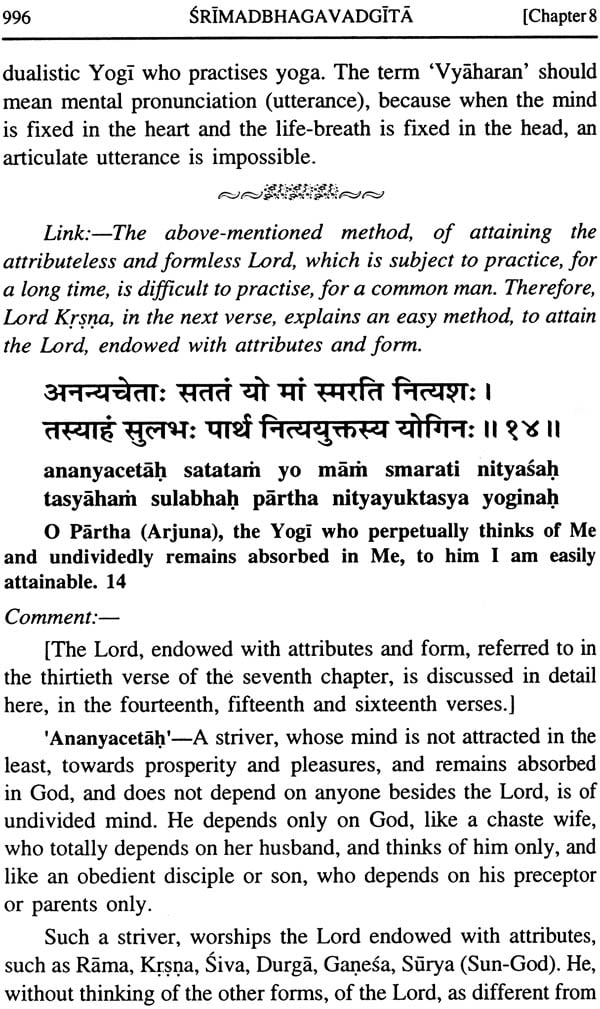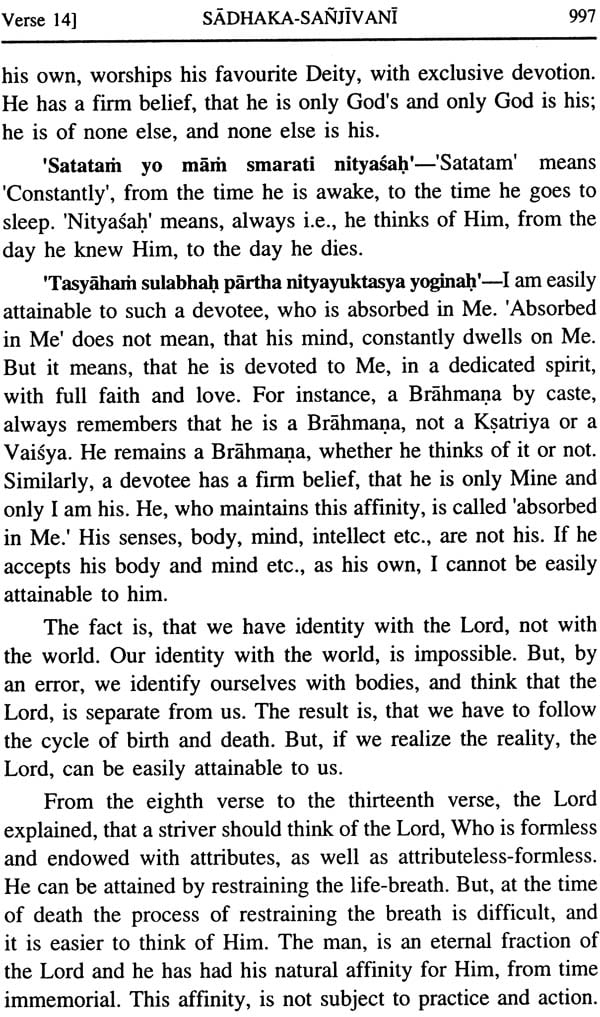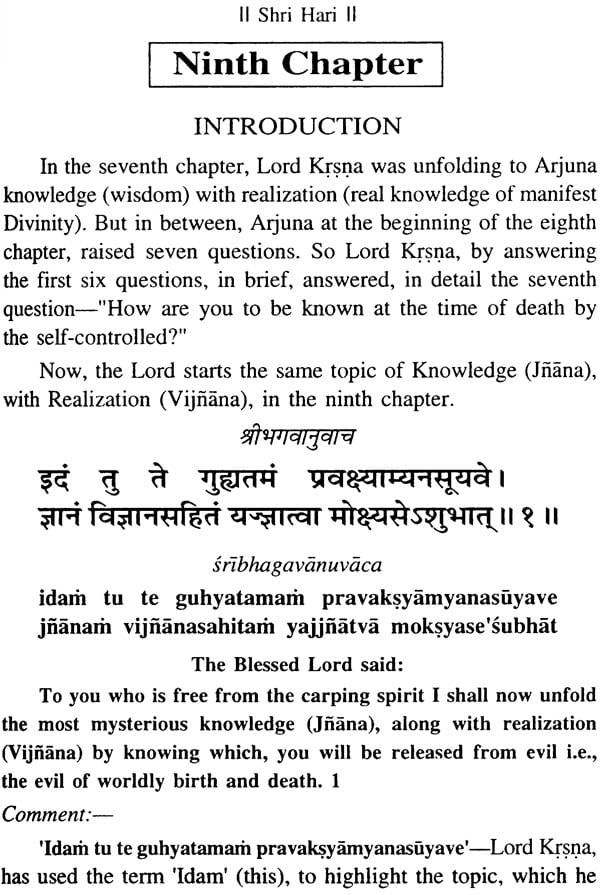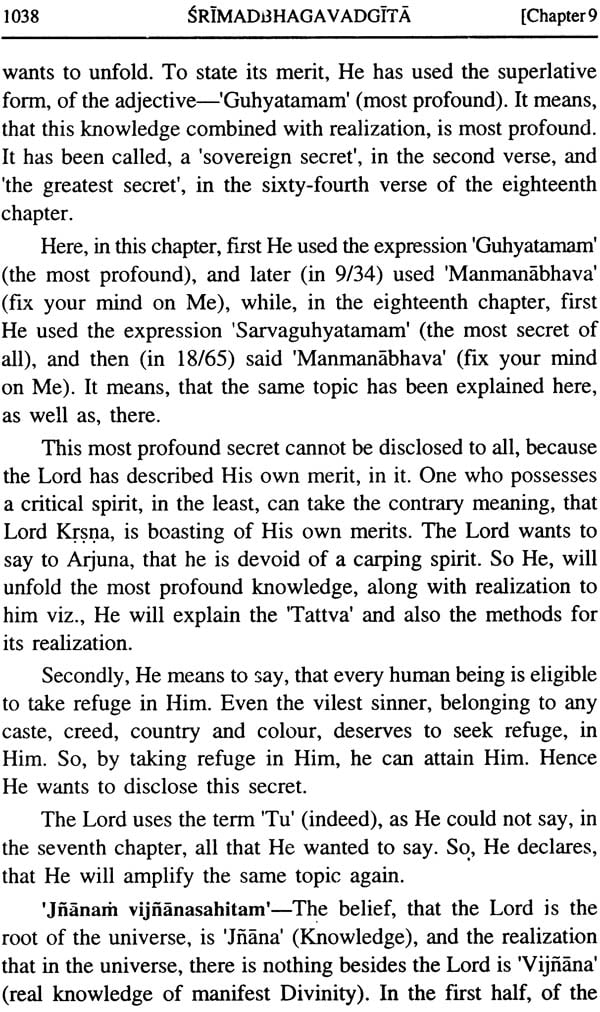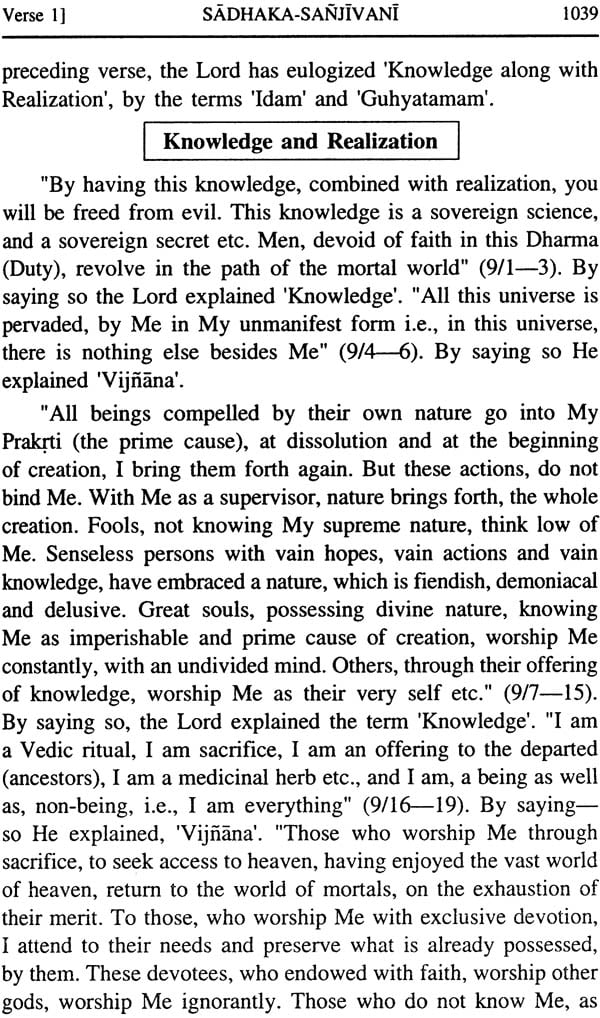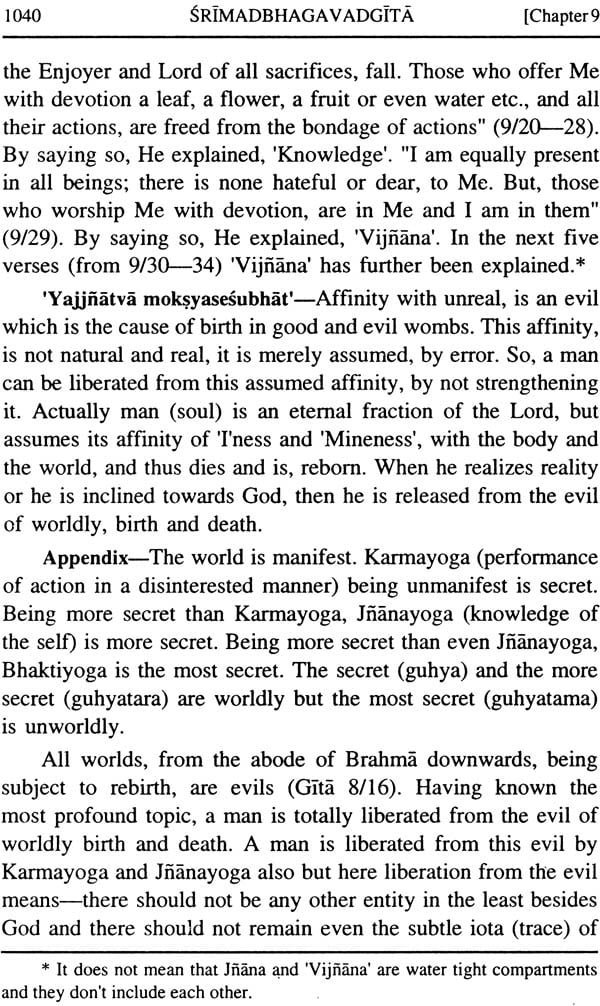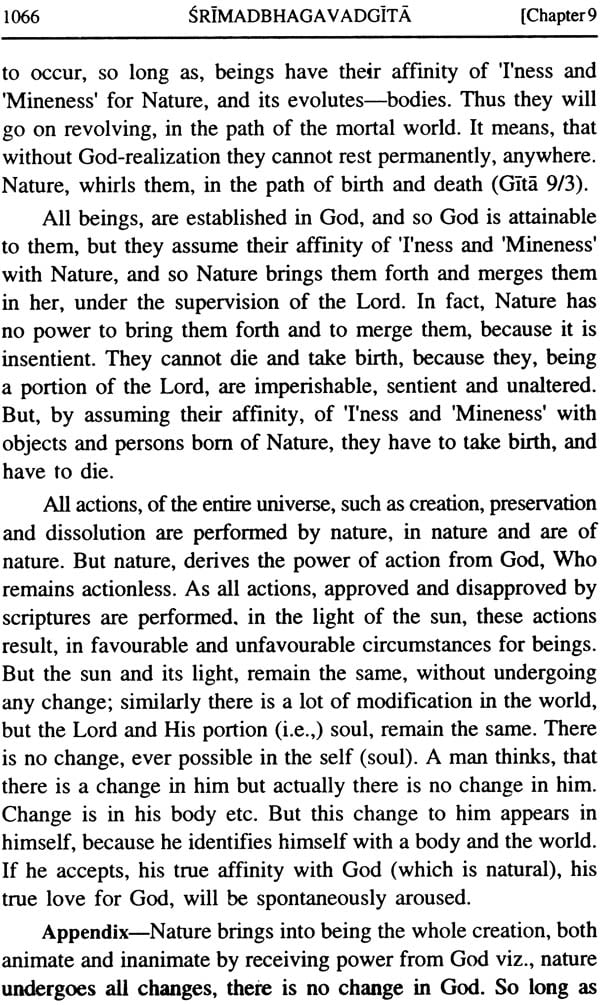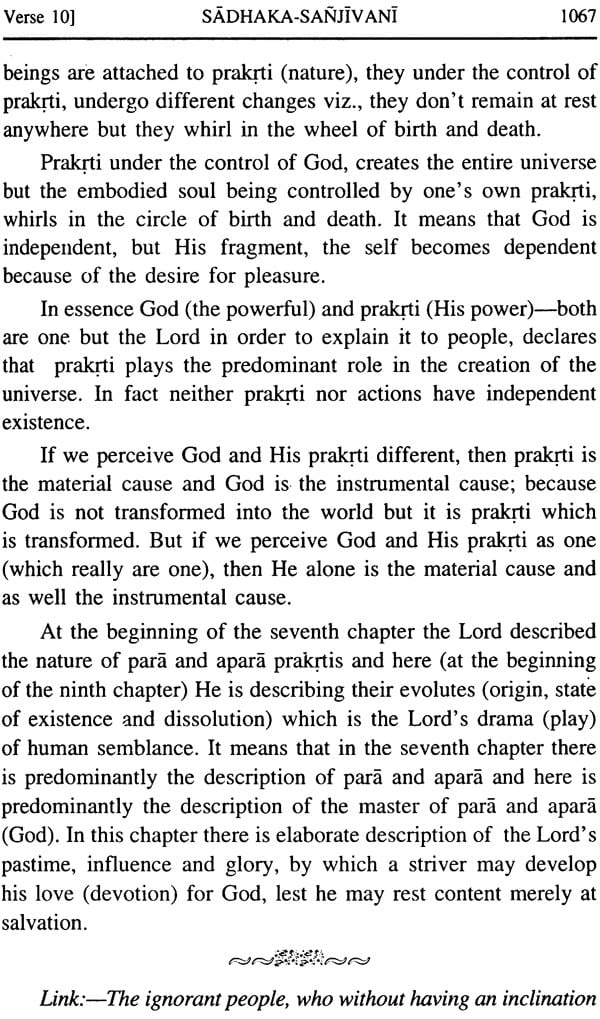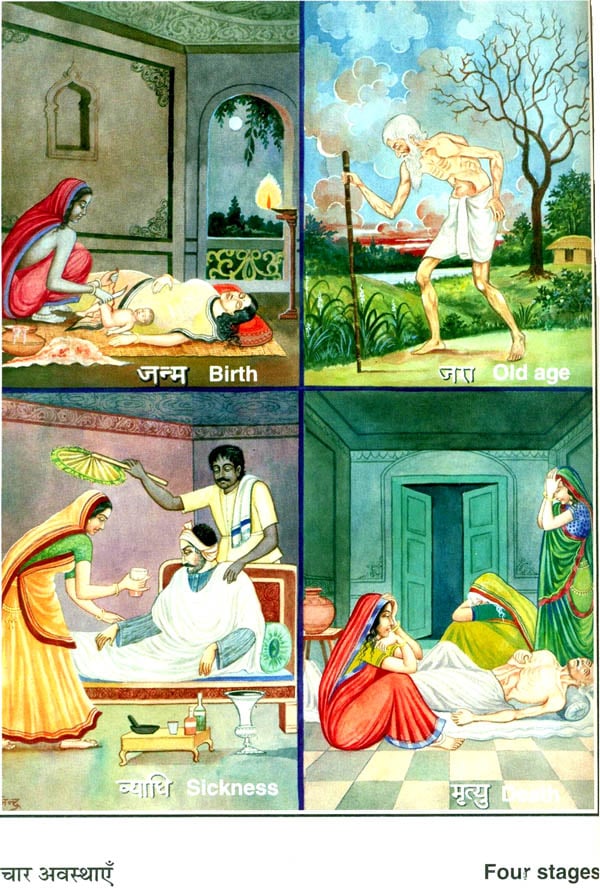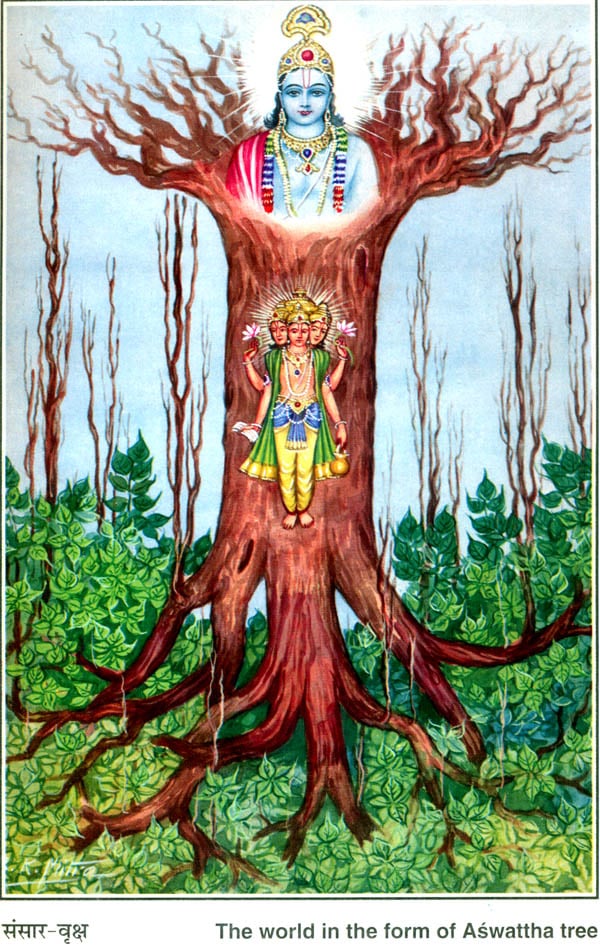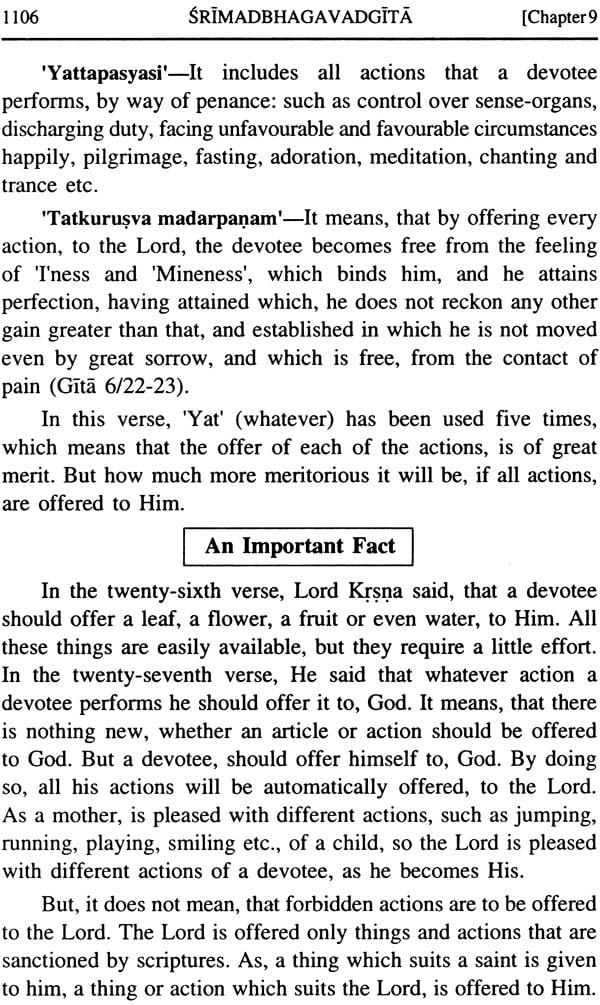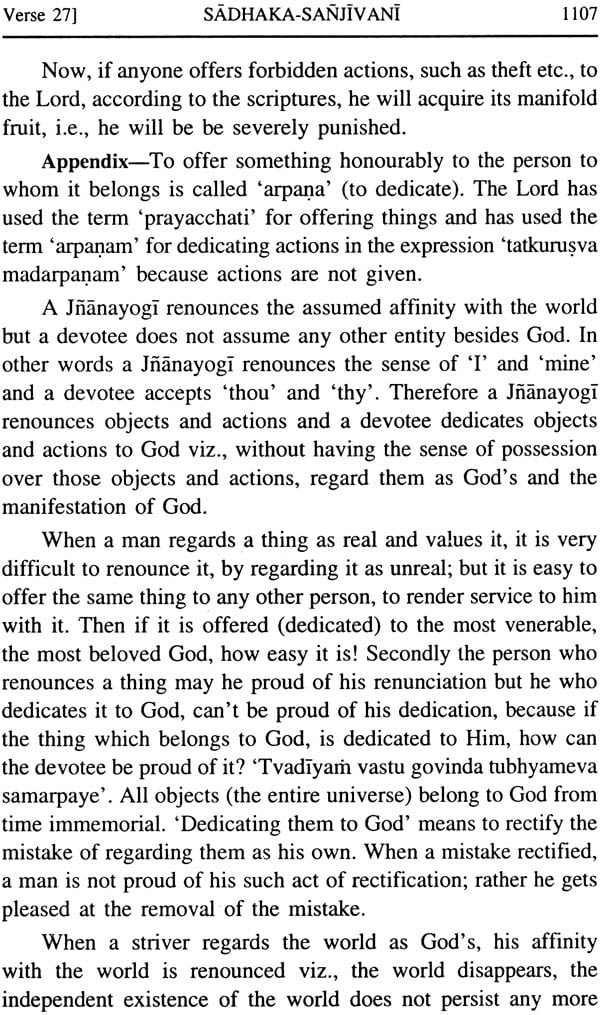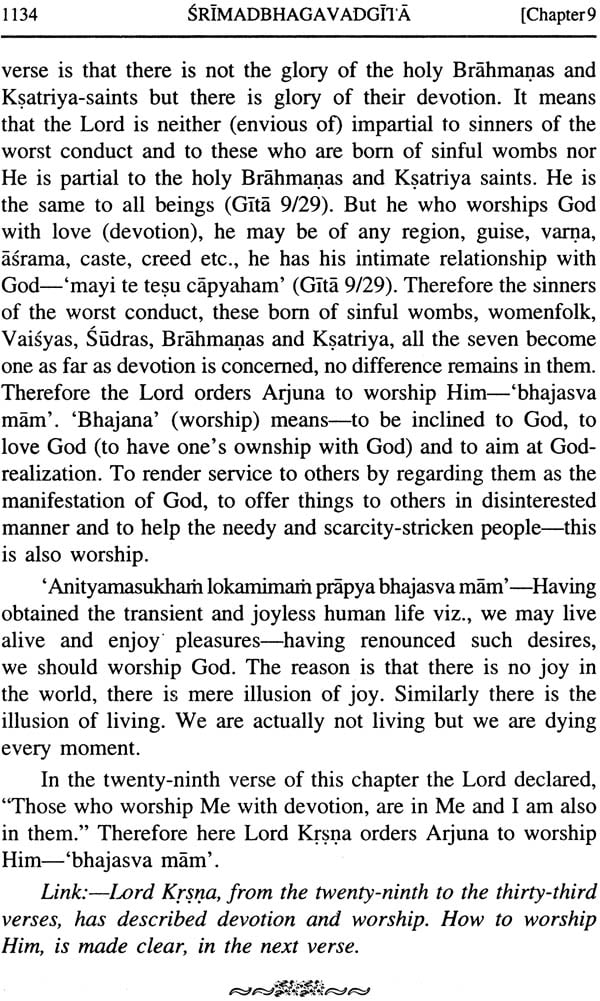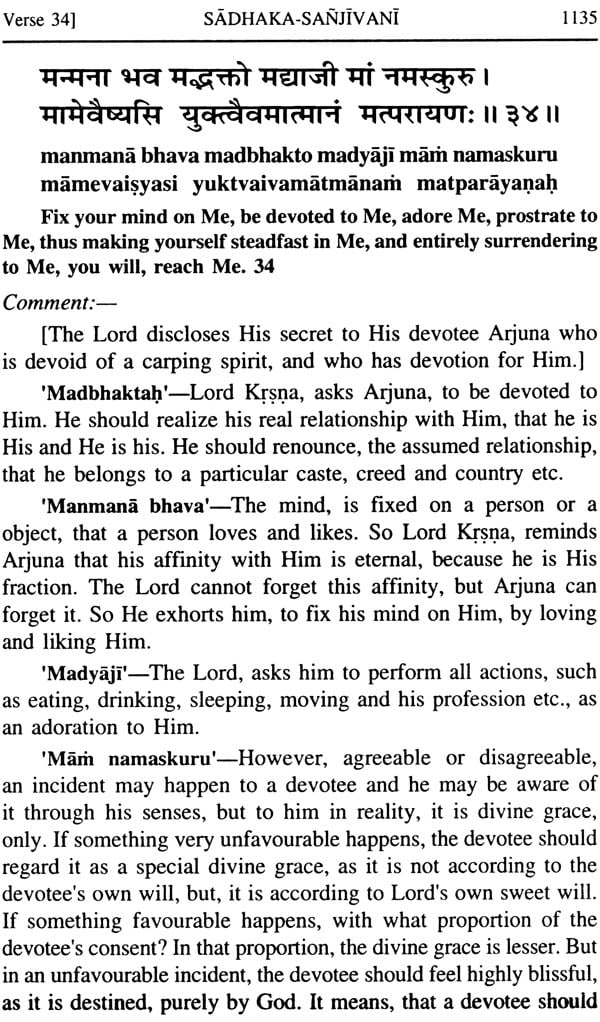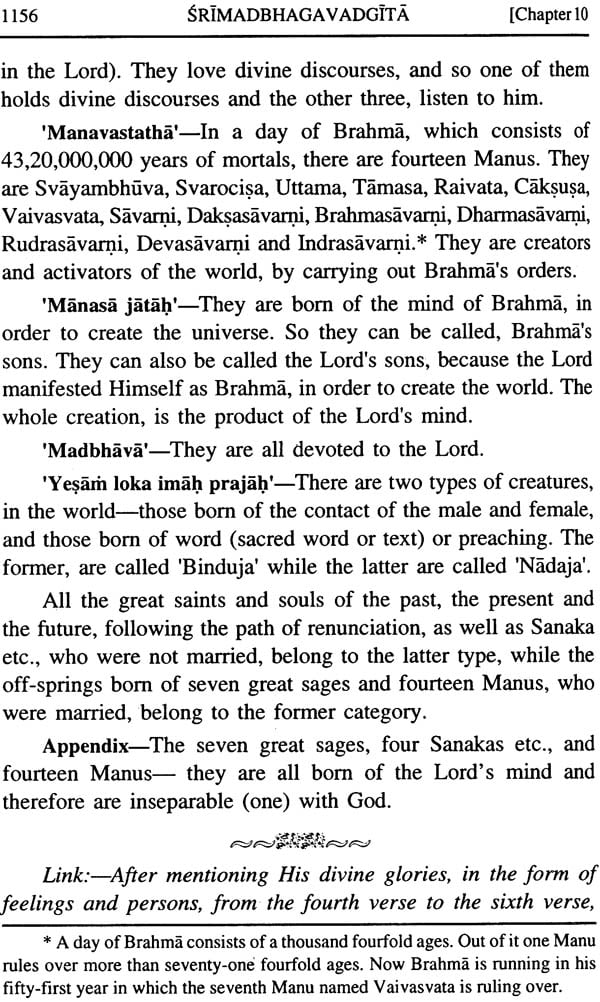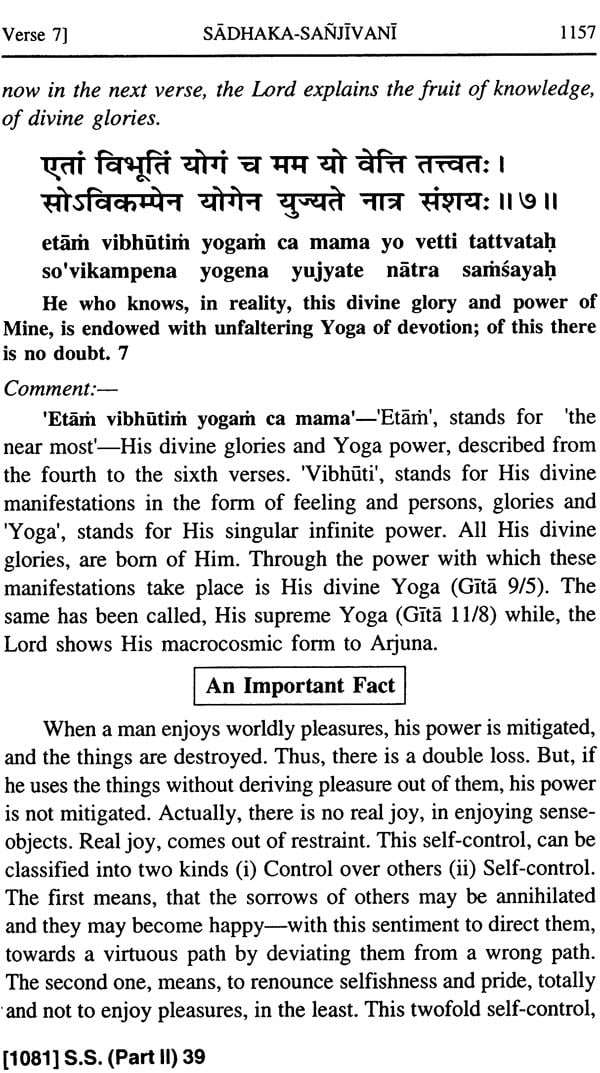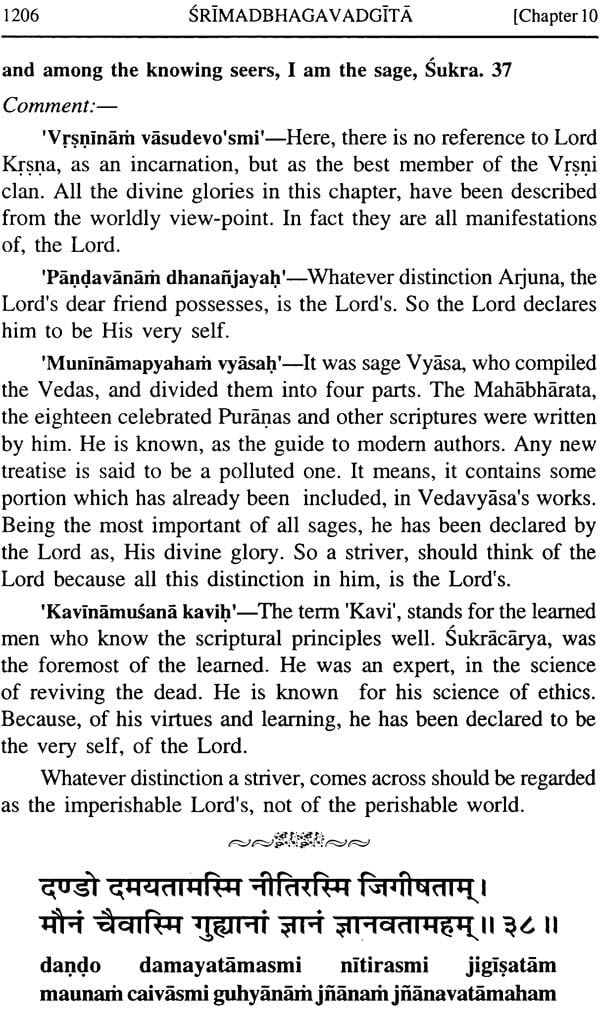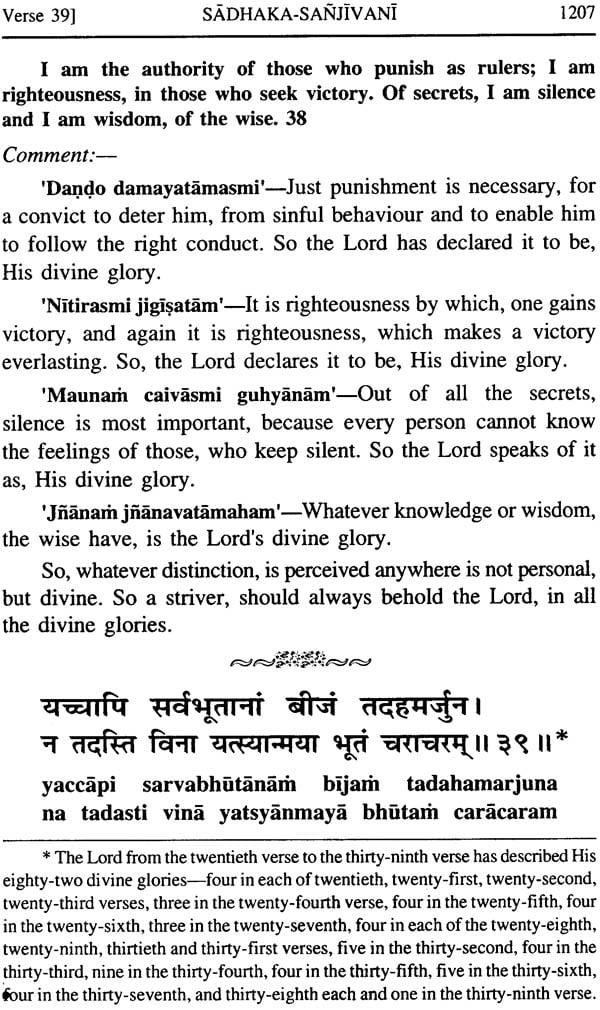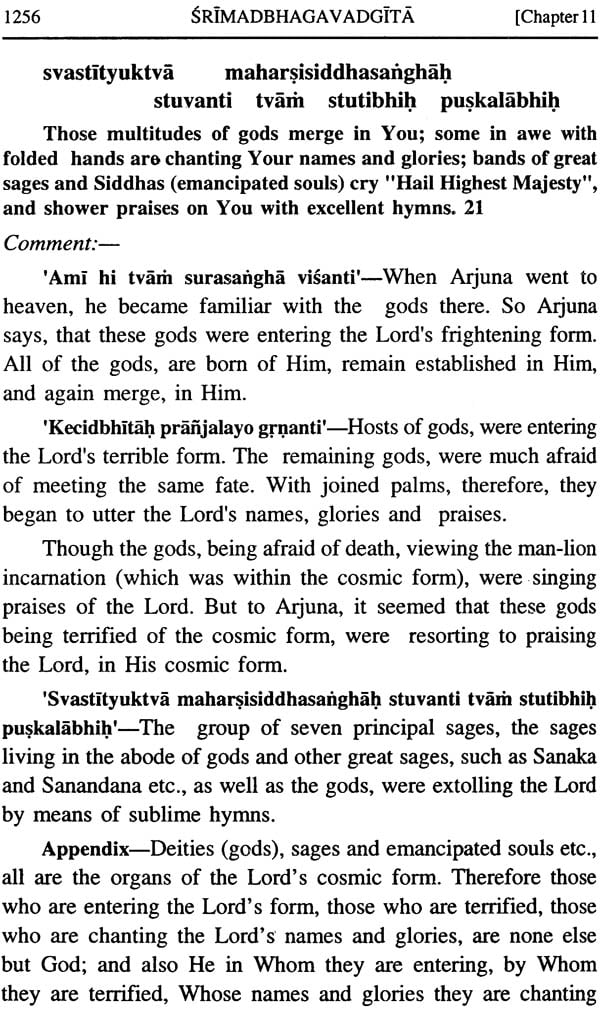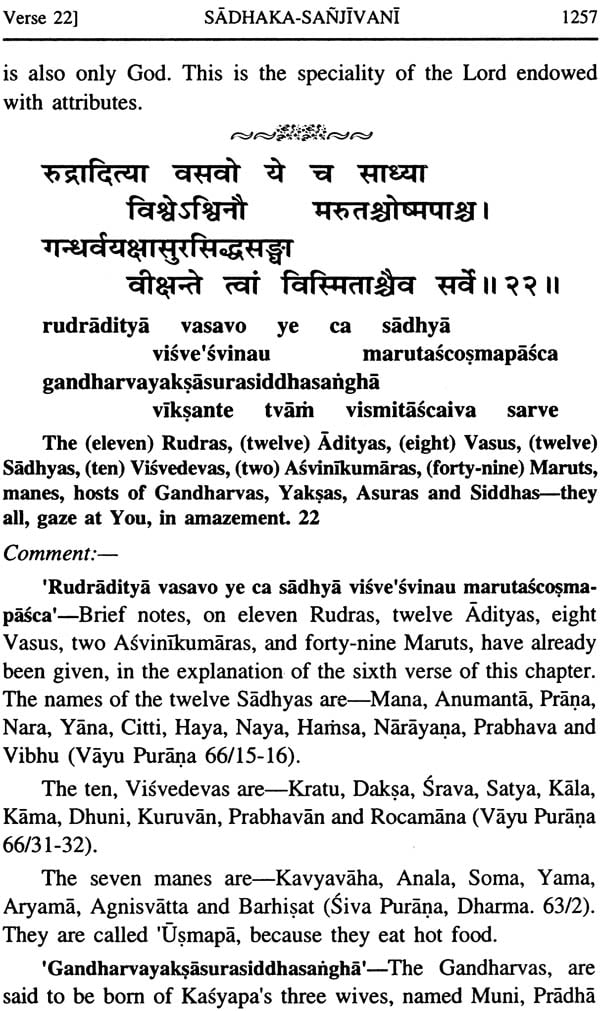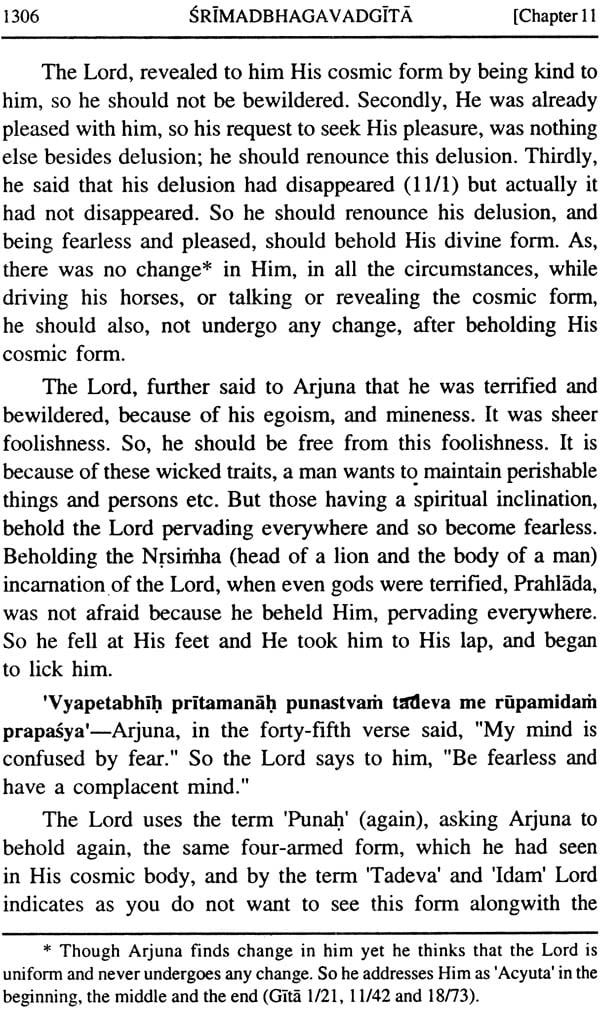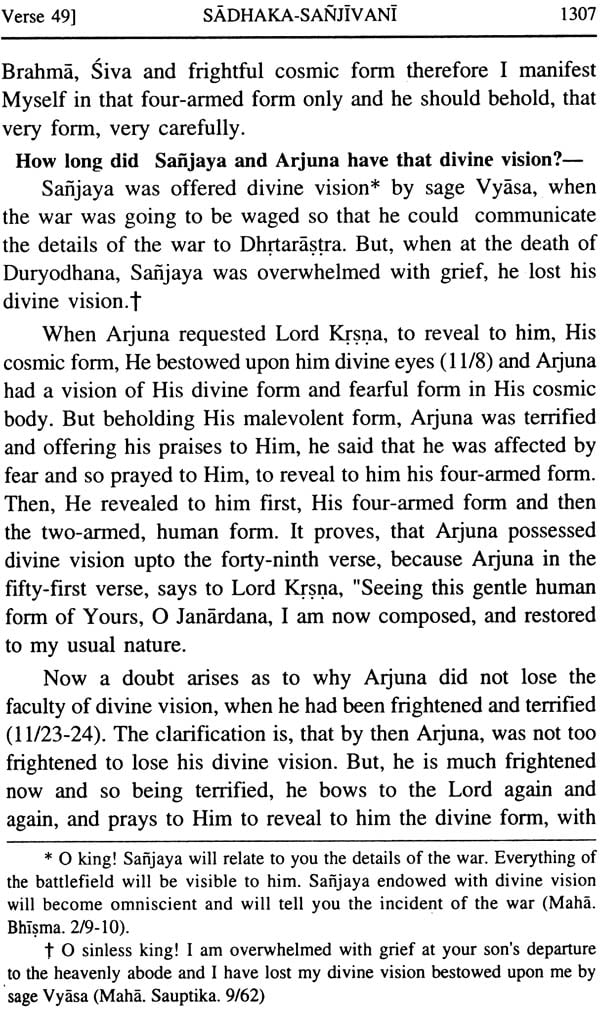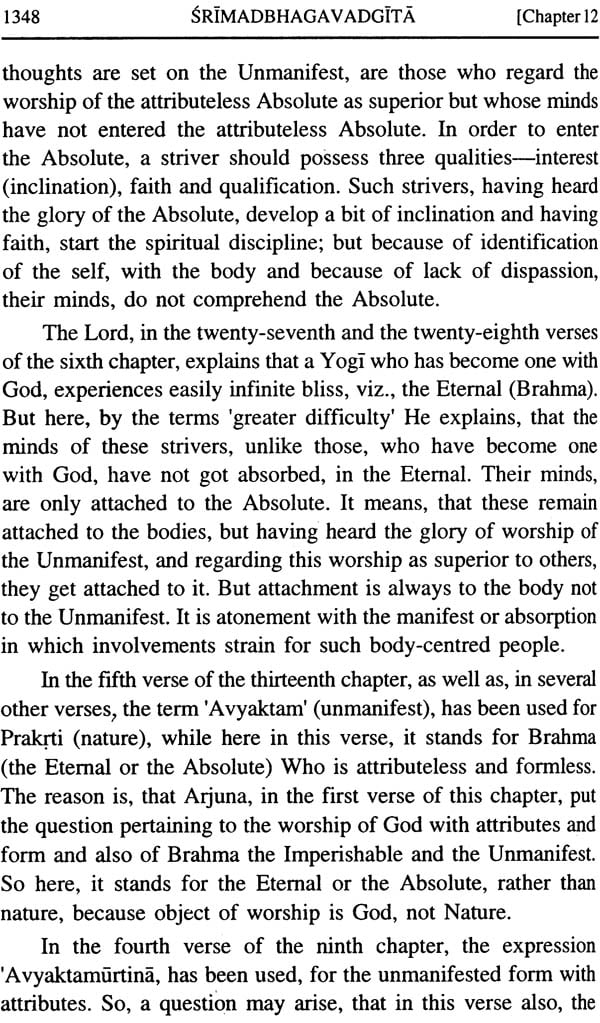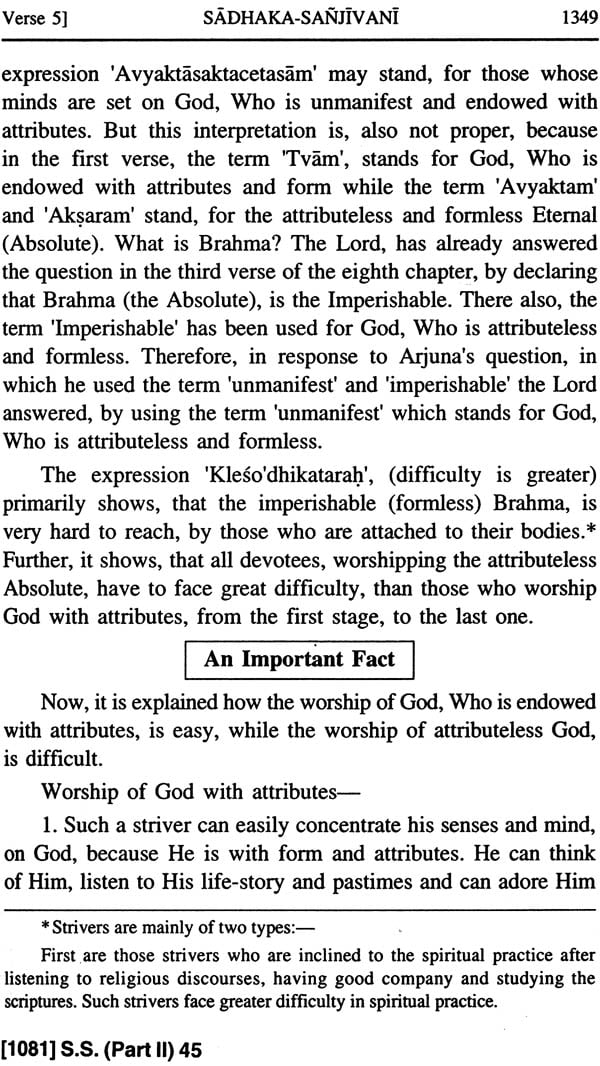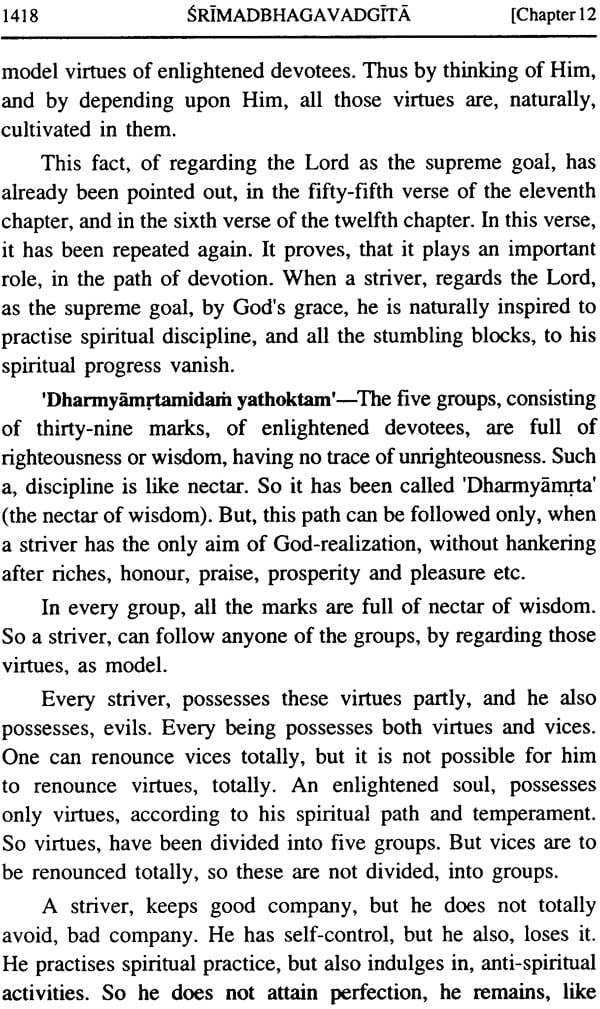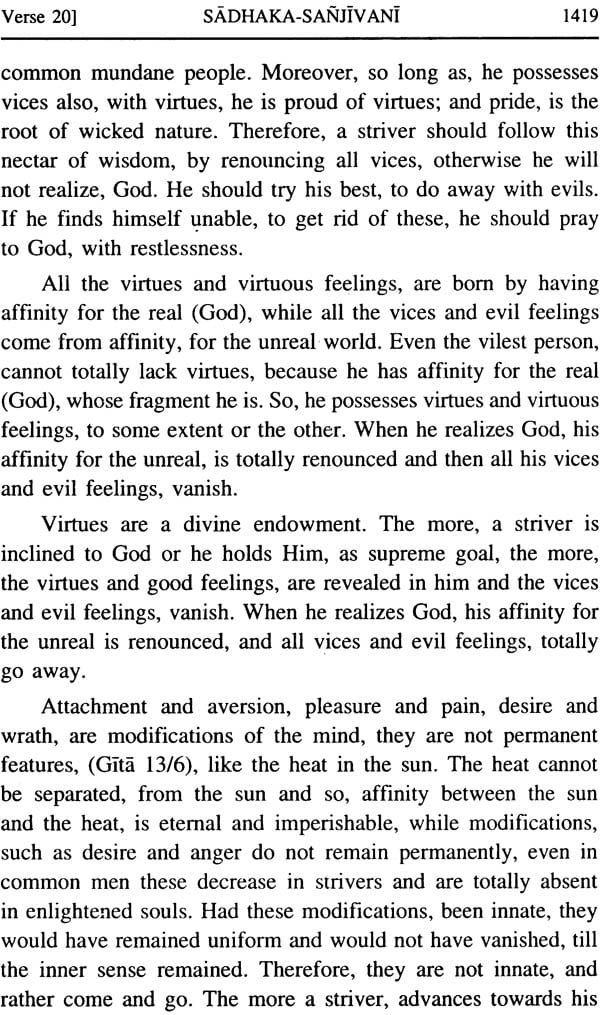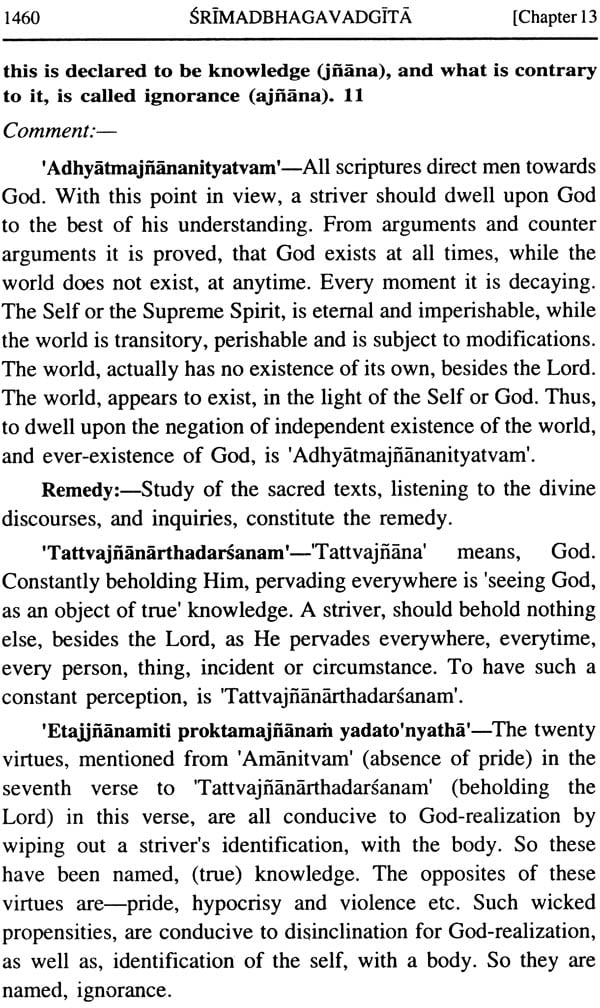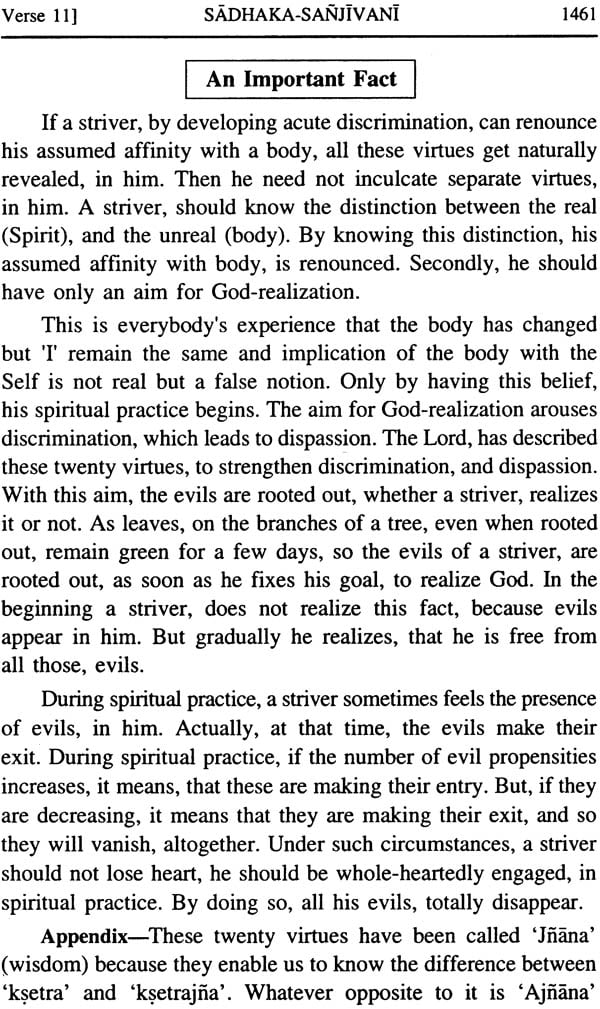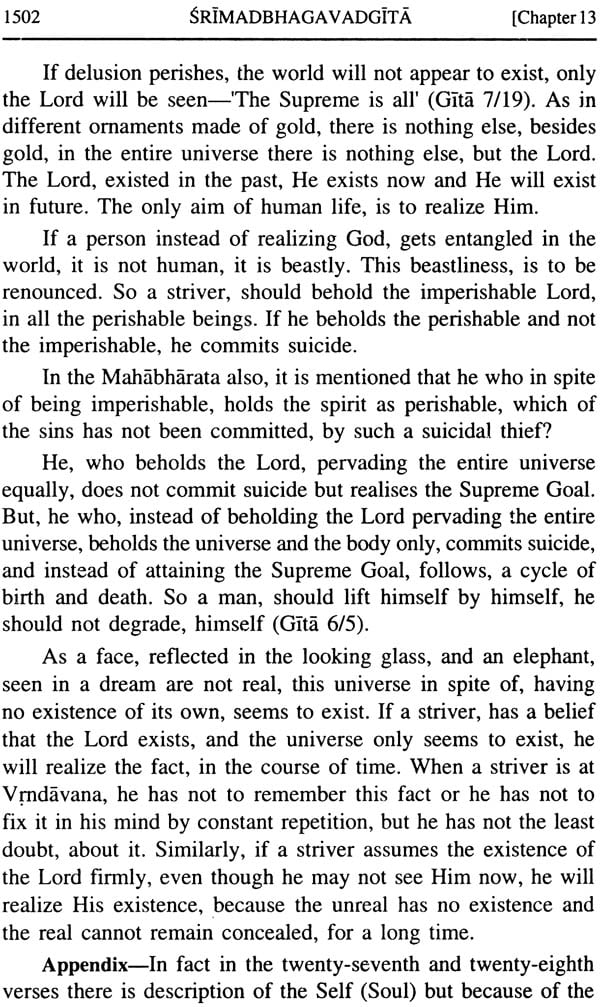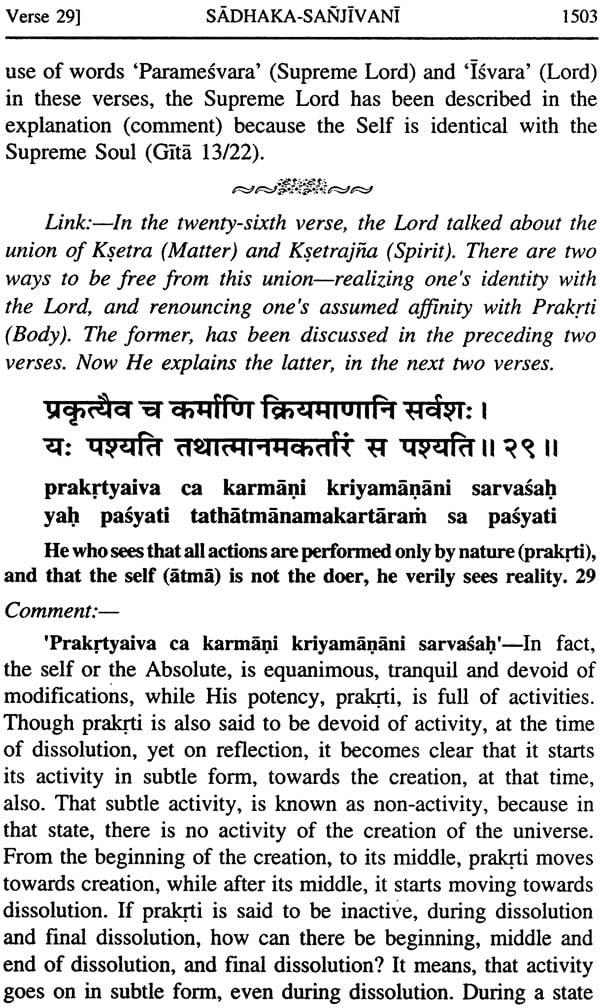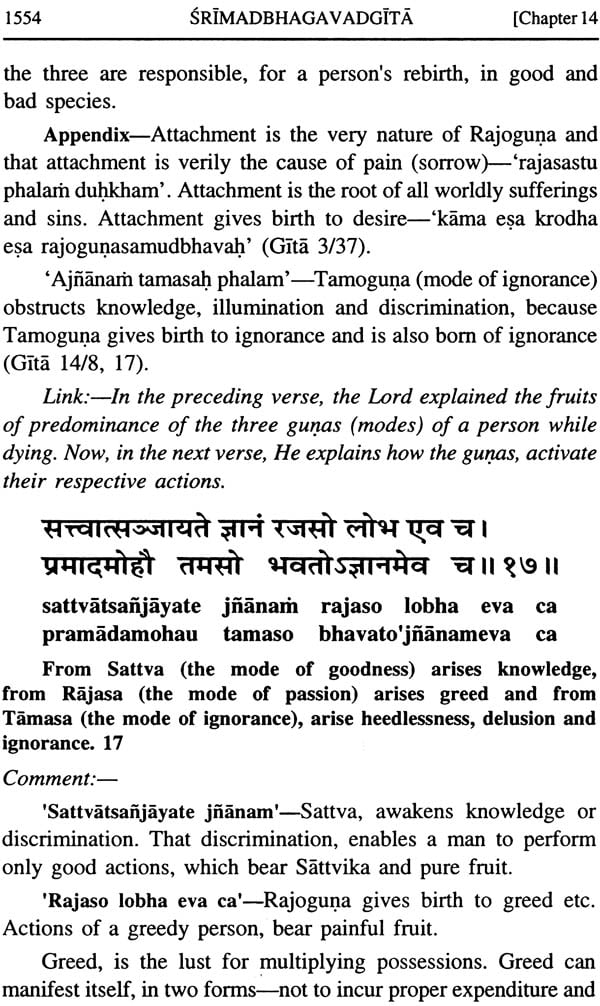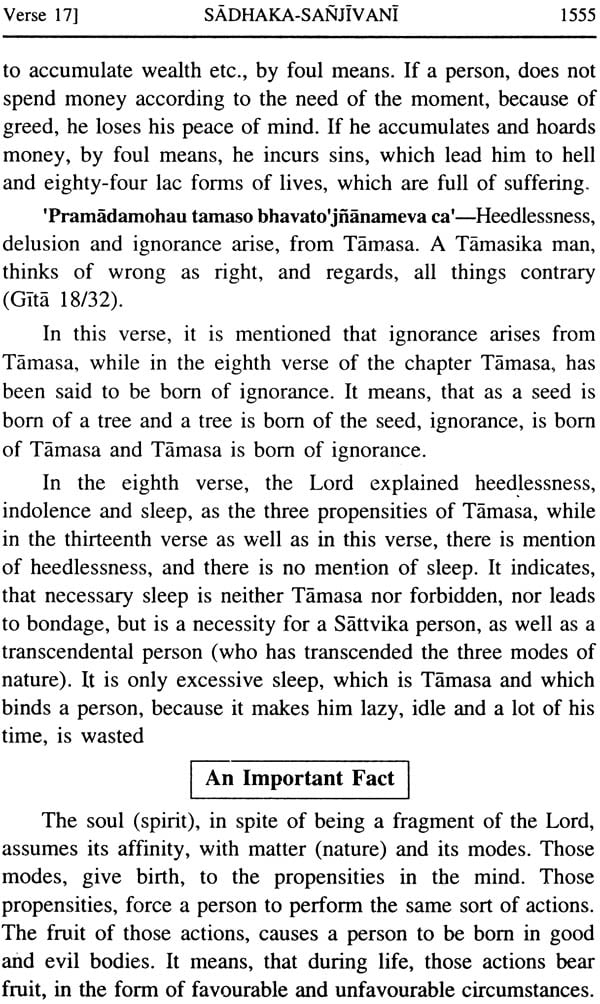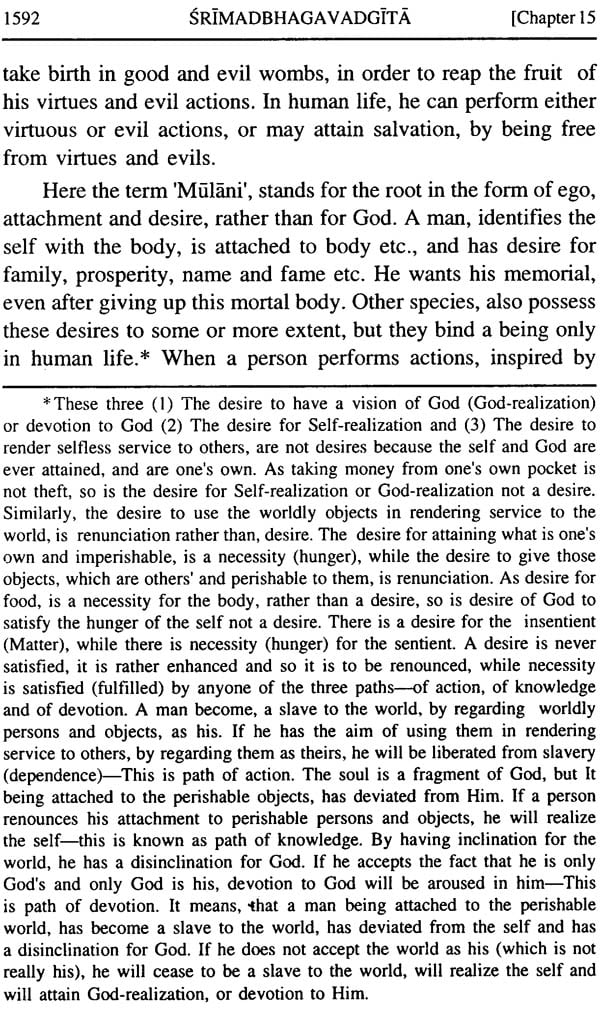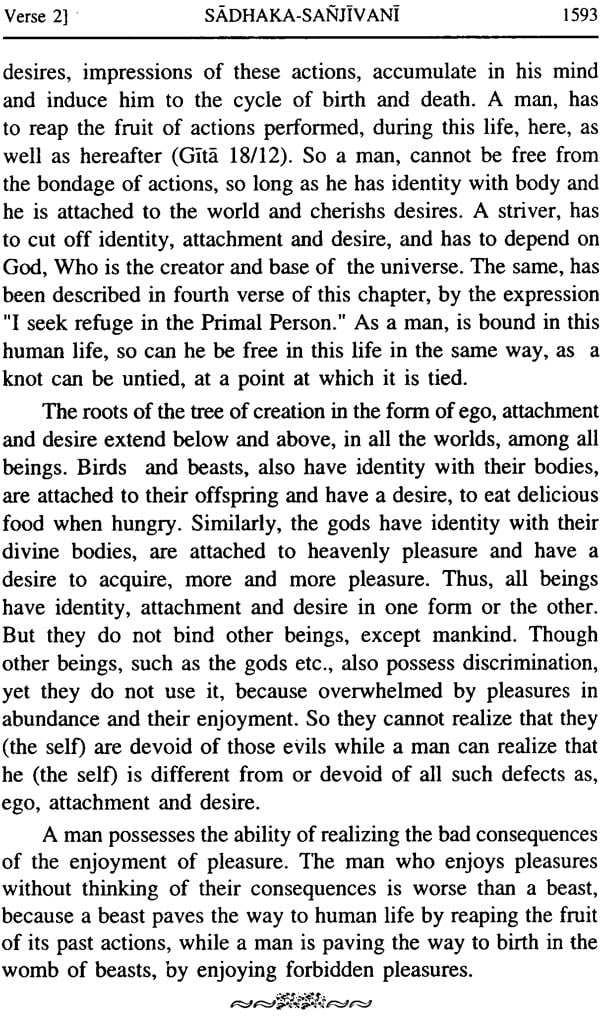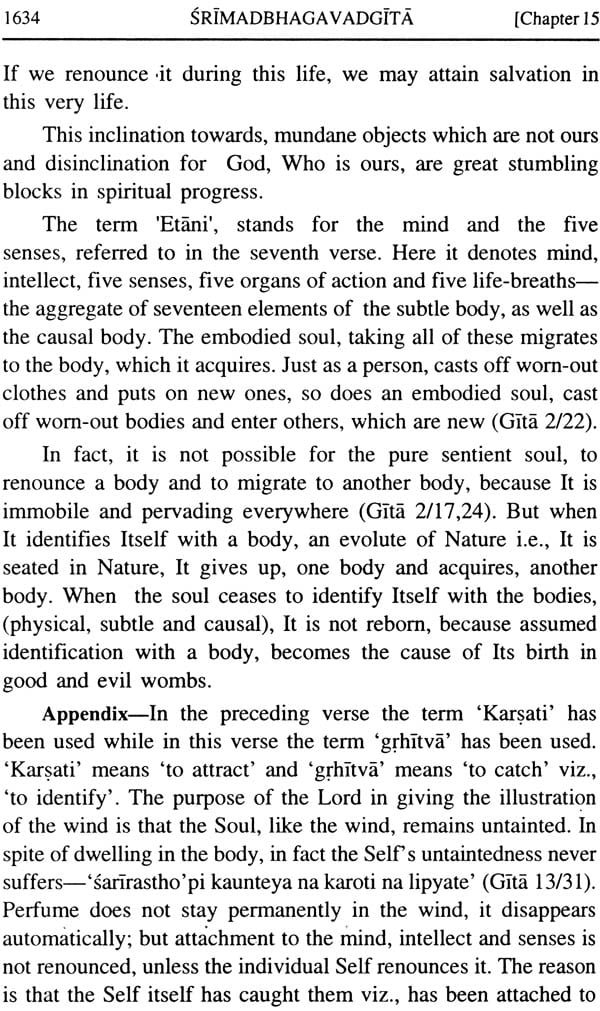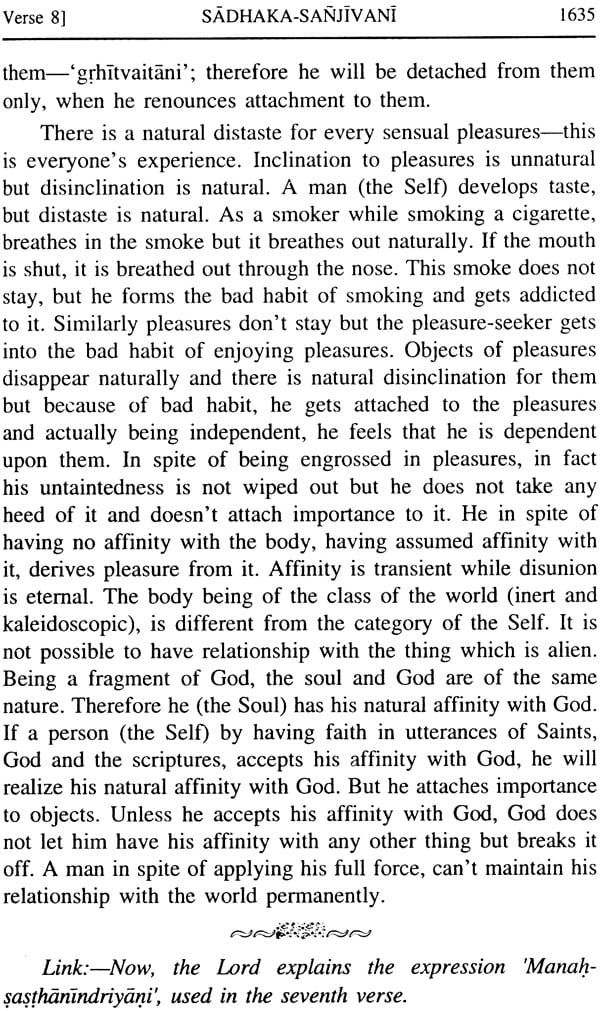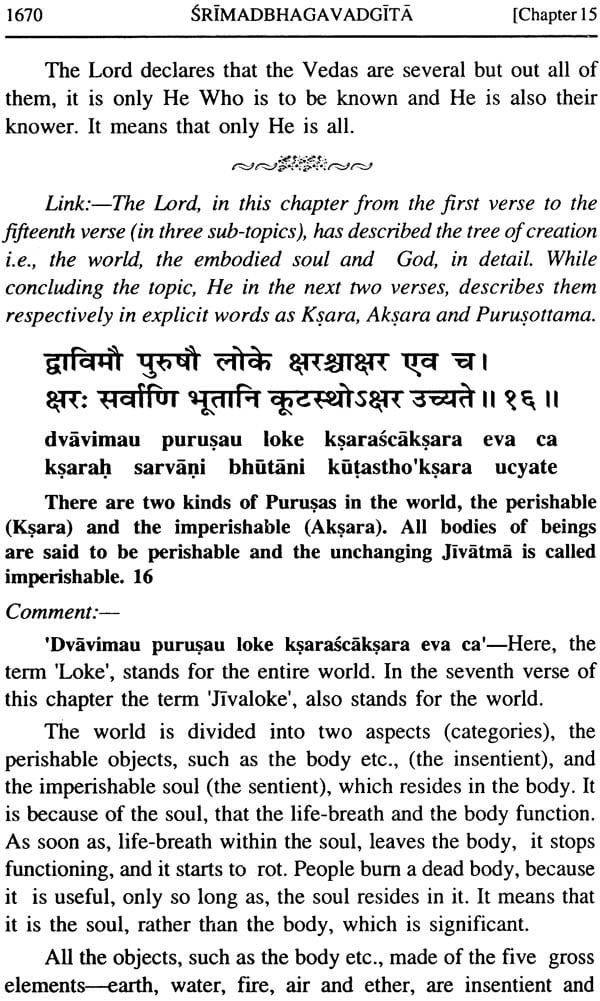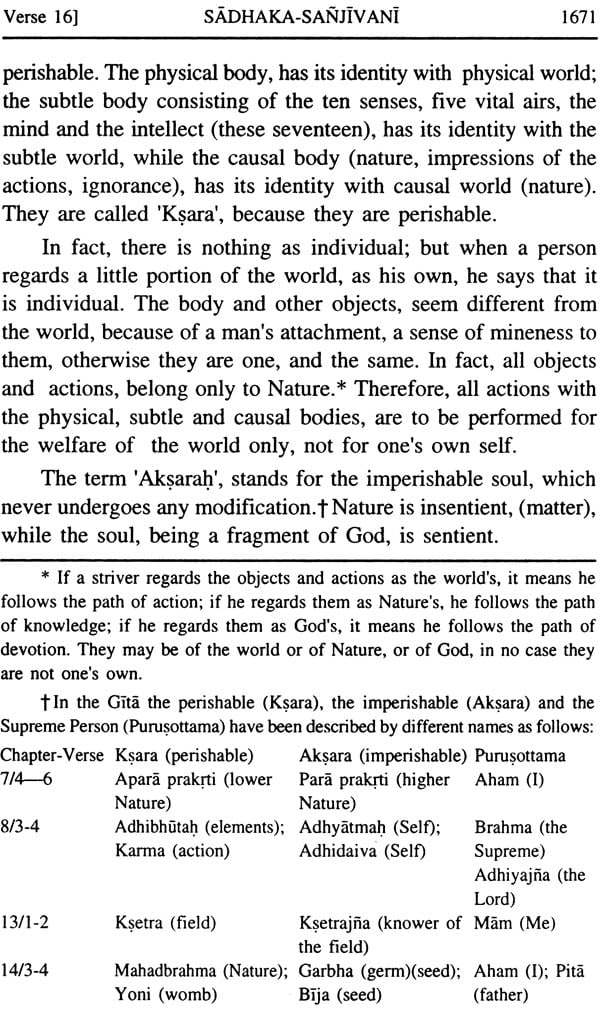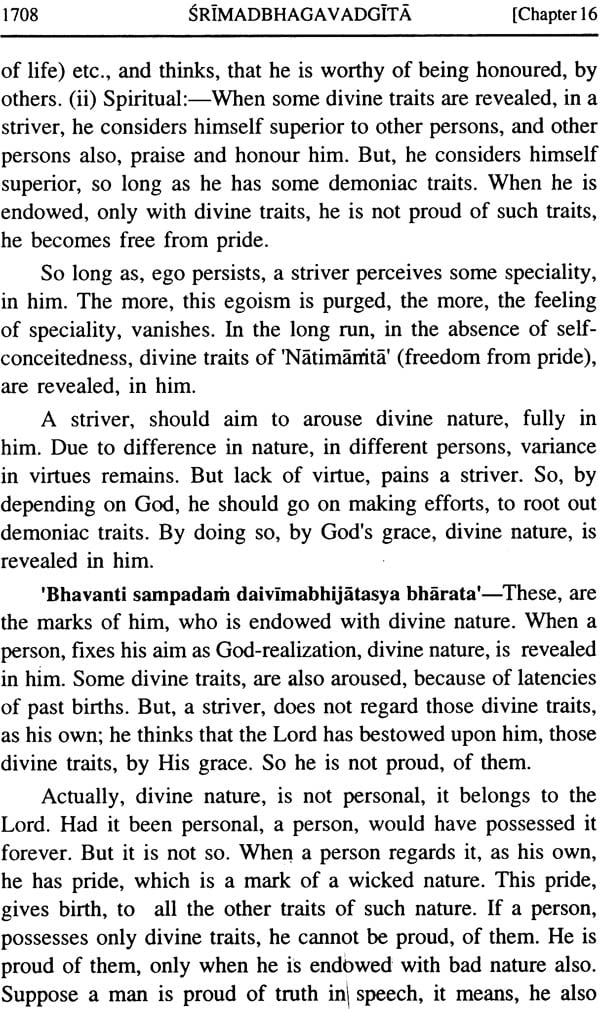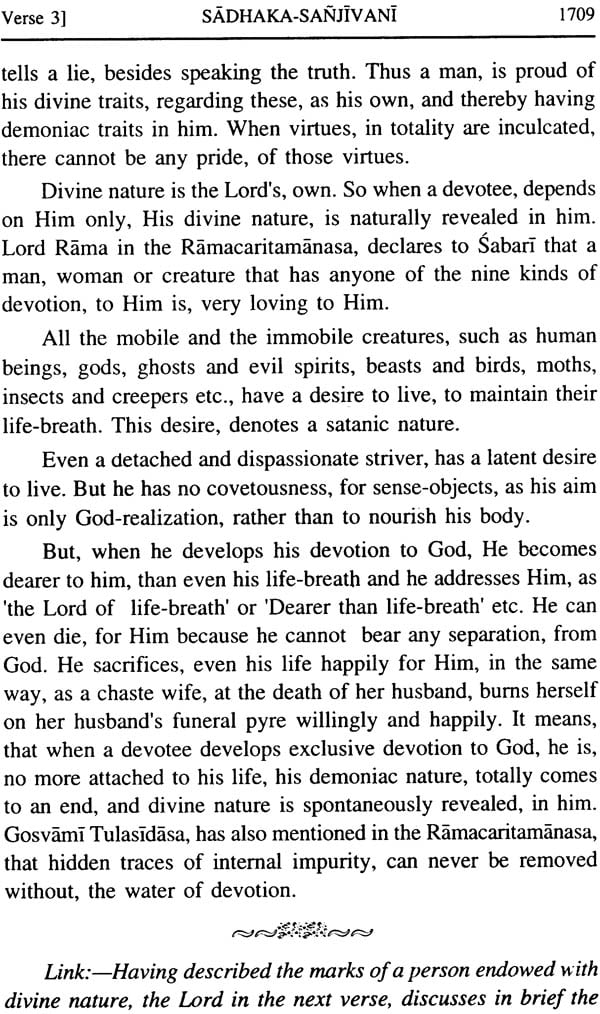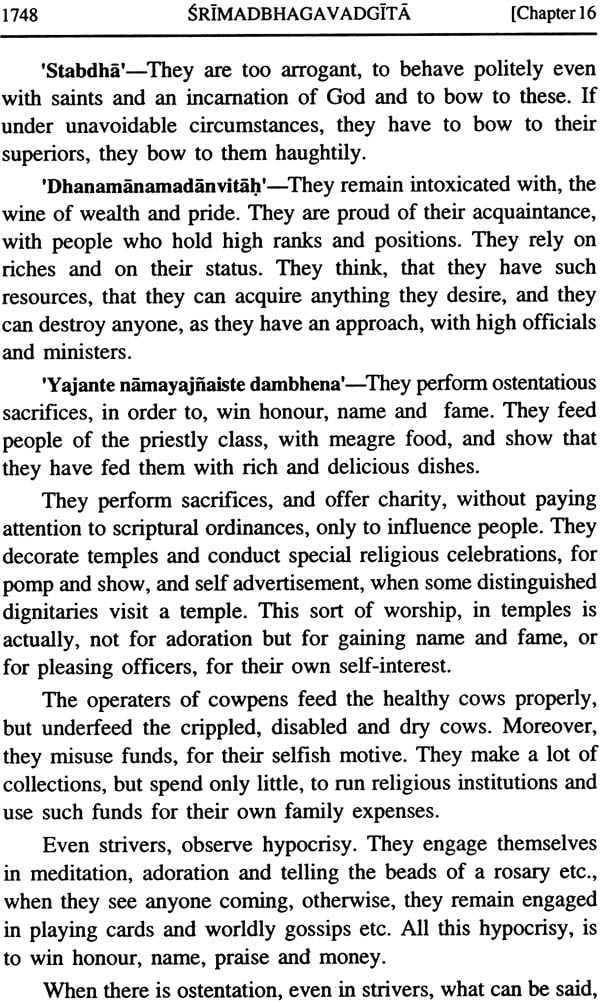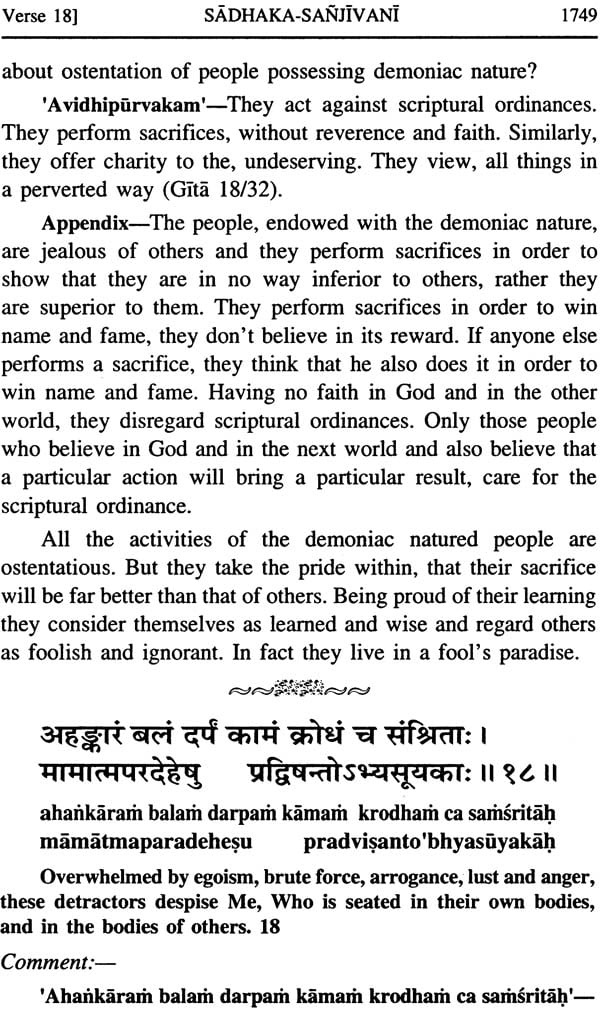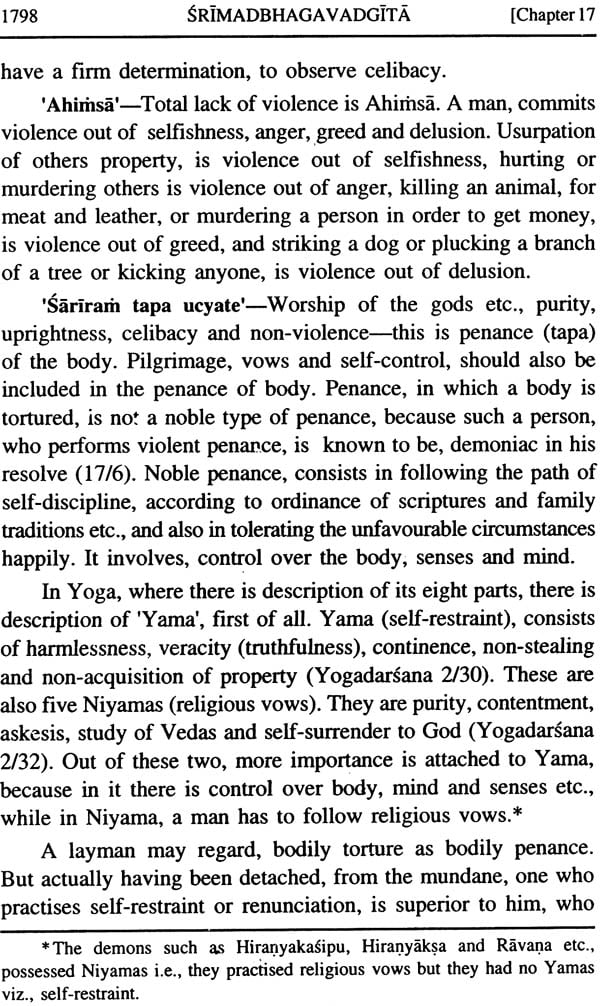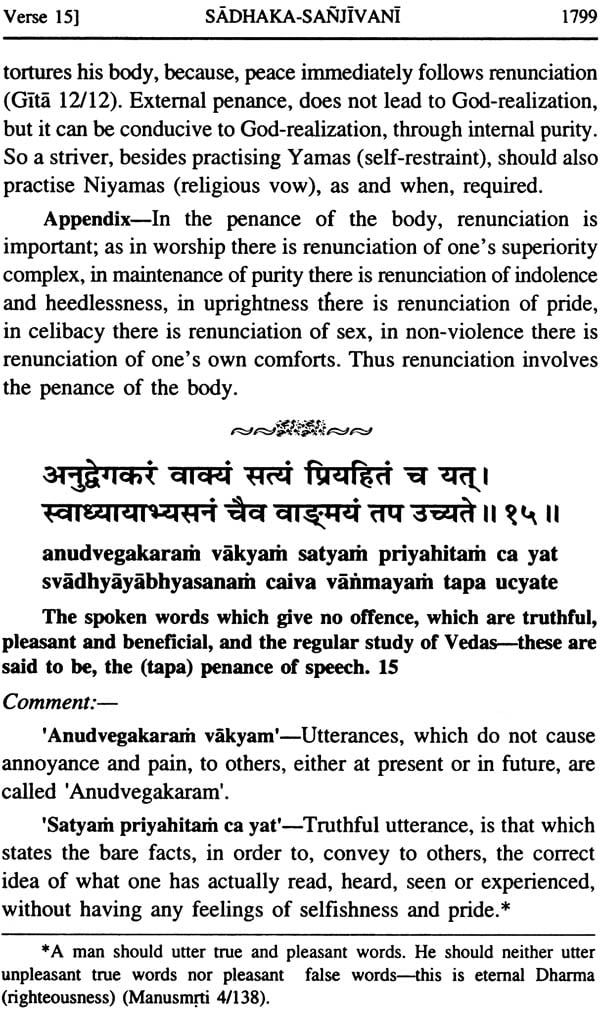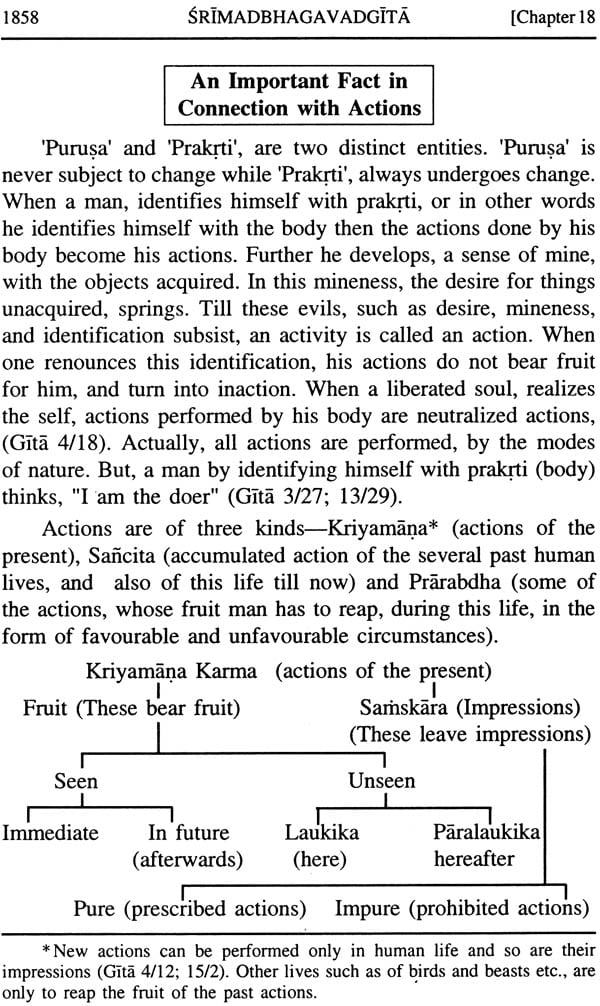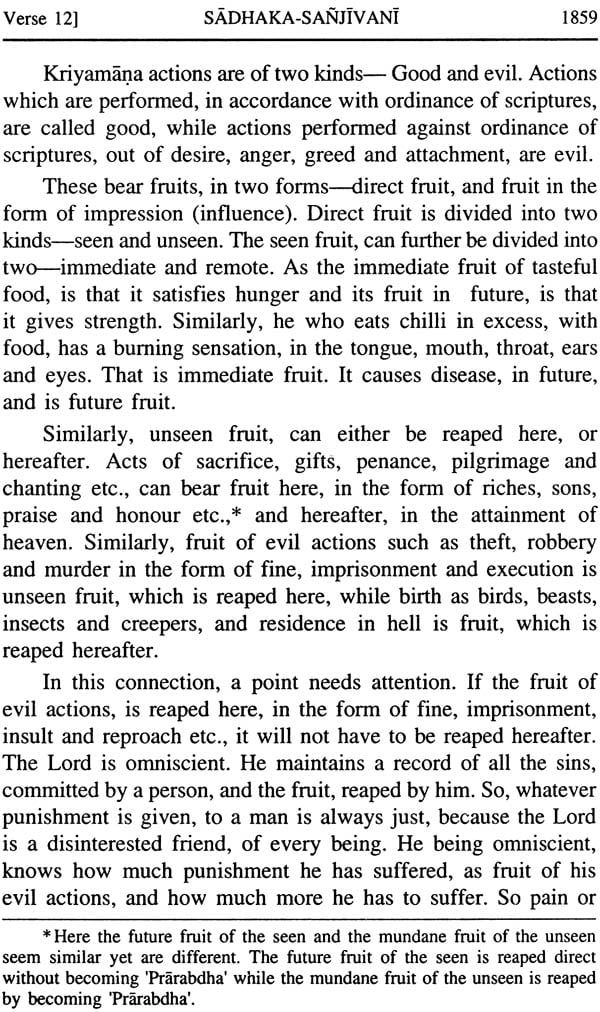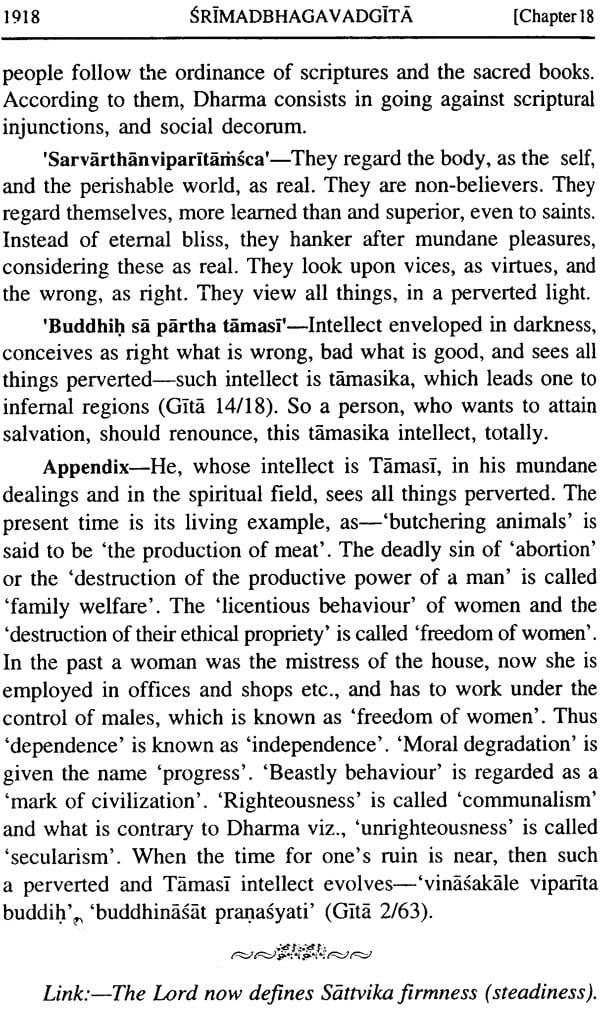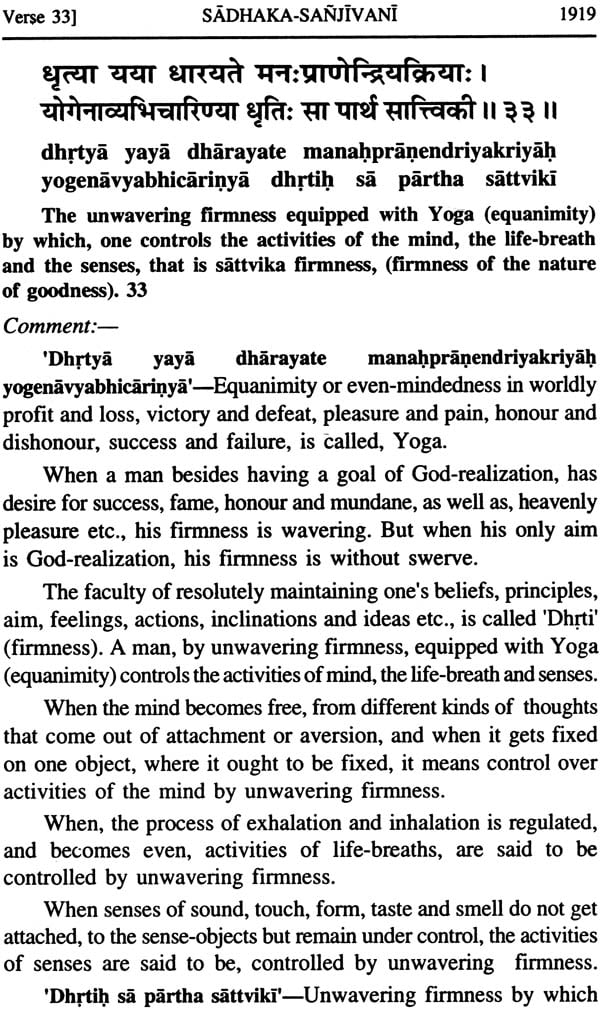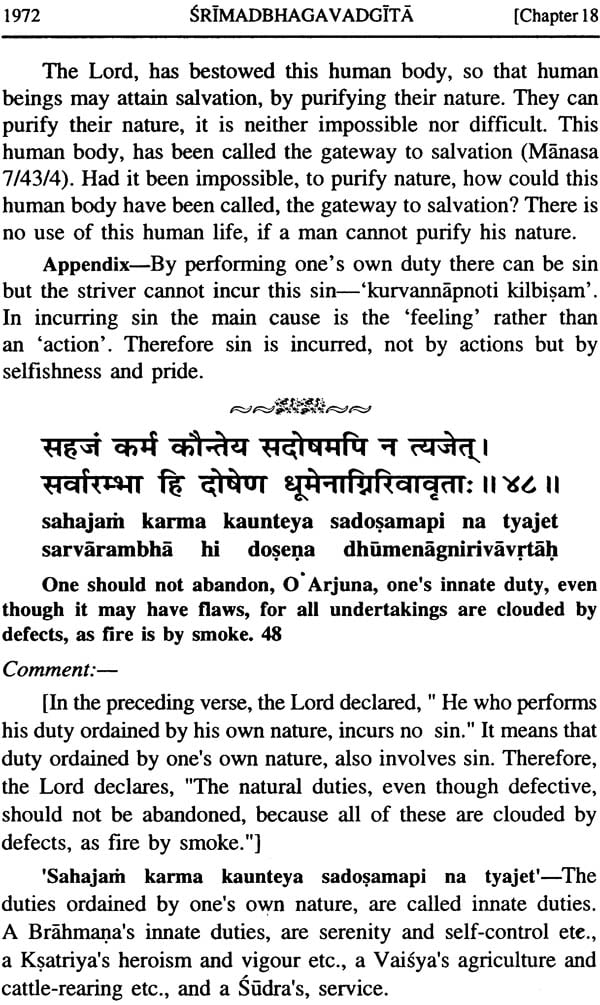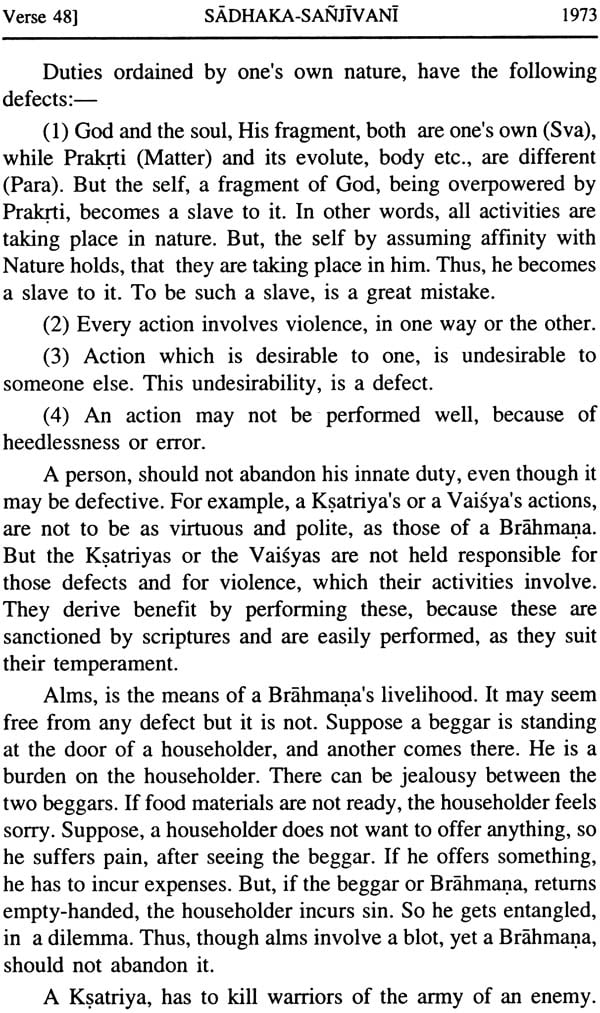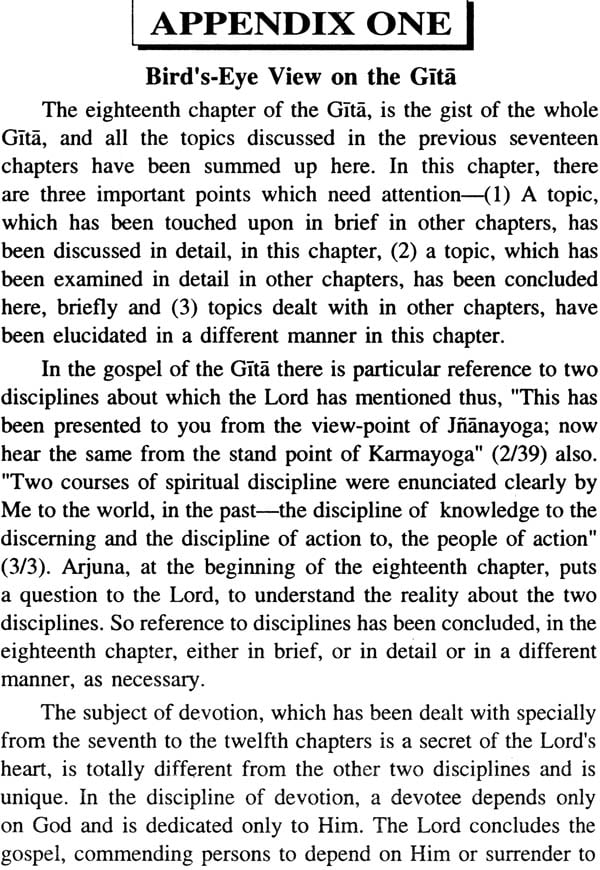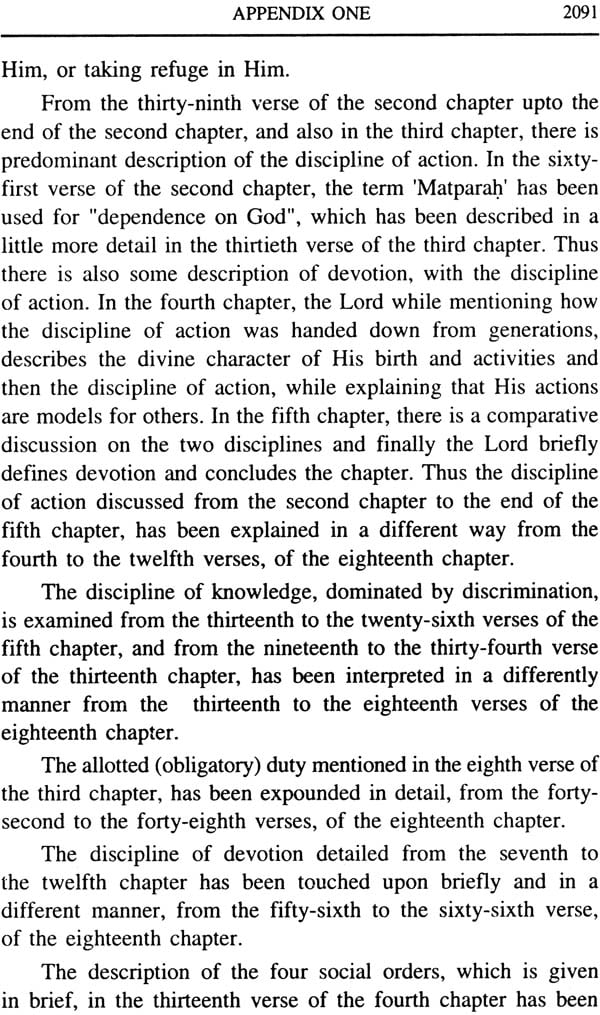
Srimad Bhagavad Gita - 2 Volumes (Sadhaka-Sanjivani (With Sanskrit Text, Transliteration, English Translation and Commentary)
Book Specification
| Item Code: | IDF062 |
| Author: | Commentary By Swami Ramsukhdas |
| Publisher: | Gita Press, Gorakhpur |
| Language: | English |
| Edition: | 2014 |
| ISBN: | 812930063X; 8129300648 |
| Pages: | 2157 (Color Illus: 22) |
| Cover: | Hardcover |
| Other Details | 8.4" X 5.6" |
| Weight | 2 kg |
Book Description
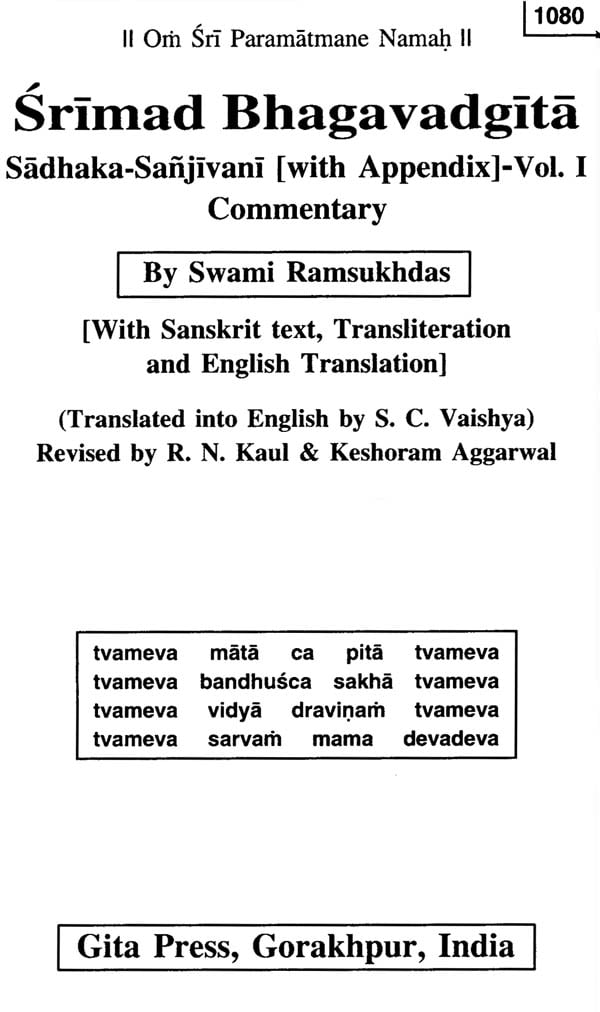
Title: Srimad Bhagavadgita
Publisher's Preface:
Srimad Bhagavadgita holds an incomparable and unique position in world literature. It recalls the divine voice of Lord Krsna, through which many of His mysteries and inner secrets are revealed. In communicating these for the benefit of mankind, the Lord has invoked Arjuna, as an interlocutor or questioner. The small book, full of the Lord's extraordinary thoughts and views from the very heart, was never excelled in the past, nor would ever be, in the future.
Out revered Param Shraddheya Shri Swami Ramsukhdasji has delved deep into the bottomless depths of this profound scripture and extracted invaluable gems, which in his magnanimity, he has through his commentary in Hindi, called 'Sadhaka Sanjivani' offered for the benefit and spiritual advancement of aspirants. It is obvious that this commentary is singularly different and distinctive, in many respects, from other publications. Though we claim no far-reaching study of other critiques and annotations, yet we are struck by new interpretations, new meanings and new revelations in this commentary, arising from many verses, such as; Chapter one-Verses: ten, nineteen, twenty and twenty-five; Chapter two-Verses: thirty-nine and forty; Chapter three-Verses: three, ten, twelve, thirteen and forty-three; Chapter four-eighteen and thirty-eight; Chapter five-Verses: thirteen and fourteen; Chapter six-Verses: twenty and thirty-eight-Verse: six, Chapter nine-Verses: three and thirty-one: Chapter ten-Verse: forty-one; Chapter eleven- Verses: twenty-six, twenty-seven, forty-five and forty-six; Chapter twelve-Verse: twelve; Chapter thirteen-Verses: one, nineteen, twenty and twenty-one; Chapter fourteen-Verses: three, twelve, seventeen and twenty-two; Chapter fifteen-Verses: seven and eleven: Chapter sixteen-Verses: five and twenty; Chapter seventeen Verses: seven and ten; Chapter eighteen-Verses: thirty-seven and seventy-three etc.
We are confident that with an in-depth study of the commentary, aspirants would discover many different facets and resolutions, from these and other verses, for their better understanding and help in forging ahead with their Sadhana.
In the present times, unfortunately, there is a dearth of books, which would in simple language and with lucidity, explain and delineate the correct path and milestones of an aspirant's progress, and this void often results in their predicament. Therefore, the publication of a detailed commentary, in plain words and simple style with clarity and offering elucidation and explanation, such as this work, is at once a most welcome and important step.
Swamiji Maharaj's commentary is apparently, neither intended to promote a new or particular philosophical viewpoint, nor in the least, a means to display learning; but that it should and would act as a life-giving boon, like the Sanjivani herb, for all aspirants, no matter which creed, faith, religion or language or place, they belong to. The Buddhist, Jain, Parsi, Muslim, Christian and others etc; in studying this book, would discover in it, a basis for their advancement, in accordance with and supportive of the tenets of their individual faiths or religions and they would find enough material in this book, to help achieve their spiritual goals.
To gain spiritual bliss, we humbly urge aspirants to study the commentary deeply and sincerely, understand the writing and endeavour to put into practice the contents, for their own forward progress in the world.
Preface to the First Revised Edition
Srimad Bhagavadgita-Sadhaka Sanjivani-with commentary by Param Shraddheya Shri Ramsukhdasji Maharaj in its English version has, on all hands, been an outstanding and much appreciated exposition of the divine and immortal work. It has been reprinted before and is now ready for another printing. Time was, therefore, opportune for a revision of this masterly analytical and exhaustive commentary, so that, if necessary, clarify and amplify comments in order to enhance its understanding and gainful usefulness.
The result may be called a revision or a mere new work. It is a revision, in as much it retains the basic concept, approach and arguments of the first edition. What is new, however, is the elucidation and precise explanation of some comments in English, in order to eliminate any possible ambiguity or loss of clarity. It is in this light that changes made must be read. The amendments are unpretentious, and are intended to make reading easy.
The book is, at the same time, somewhat new, in as much as, an opportunity has been taken, importantly, to include-with the approval of the author, Param Shraddheya Shri Ramsukhdasji Maharaj-two additional and valuable appendices at the end of the commentary on the Gita. The first Appendix entitled, "A birds eyeview of the Gita", is a summarized essence of the scripture, highlighting its core and offering a capsulised version for quick comprehension and ready reference. The second Appendix, covers the traditional and other suggested "Methods of Recitation of the Gita", to help devotees to seek and achieve spiritual benefit of worship, through the Gita. Both these sections were authored by Param Shraddheya Shri Ramsukhdasji Maharaj and originally included in his monumental and celebrated book, "The Gita Darpana- The Gita A Mirror", and published by the Gita Press.
The Publishers are confident that the changes effected, would make revised edition of the Bhagavadgita Sadhaka Sanjivani of greater to the English readers and would be acclaimed by them. This edition makes it still more comprehensive, more meaningful and beneficial for aspirants of spiritual elevation, as to students of the Gita, as well as to the perspicacious members of different creeds and faiths, ideologies and religions interested in this unique and secular publication- The words of God.
May, the publishers urge the readers to study this revised edition of the Gita, with deep profundity and put into creative practice, the knowledge gained, with a view to their advancement in the world.
Foreword
Vamsidharam tottradharam namami
Maladharam mohaharam ca krsnam
Maladharam dharmadhurandharam ca
Parthasya sarathyakaram ca devam
Karttavyadiksam ca samatvasiksam
Jnanasya bhiksam saranagatim ca
Dadati gita karunardrabhuta
Krsnena gita jagato hitaya
Sanjivani sadhakajivaniyam
Praptim harervai saralam braviti
Karoti duram pathivighnabadha
dadati sighram paramatmasiddhim
Transalation- I bow down to Krsna the Divine, the fulte-holder, holder of the reins, the usurper of hearts and infatuation, the wearer of garlands, the holder of the Axis of Dharma and the Charioteer of Arjuna.
Sung by Lord Krsna, the Gita drenched in ambrosial compassion-is the provider of initiation into duty, lessons of equanimity, alms of enlightenment and surrender and is for the welfare of mankind.
Bestower of the gift of life, this Sadhaka Sanjivani tells in simple terms the art of realizing Hari. It also removes the obstacles in the path and quickly gives the supreme accomplishment of God-realization.
By meditating and contemplating on the Gita and by preparing this commentary, I have been very much spiritually benefited; I also have a clear understanding of the subject matter of the Gita. It is my firm conviction that if our brothers and sisters reflect on it, they will also receive spiritual benediction. I do not have even an iota of doubt about it, that by meditation and contemplating on the Gita, great benefits would accrue to them.
Krsnanugrahadayika sakaruna gita samaradhita
Karmajnanaviragabhaktirasikamarmarthasandarsika
Sotkantham kila sadhakairanudinam pepiyamamana sada
Kalyanam paradevateva disati sanjivani varddhatam
Translation
May, by the Grace of Lord Krsna, the adorer and seeker of Gita, that is full of compassion, the knower of the truth of Karma (action), Jnana (knowledge); viraga (renunciation) and Bhakti (devotion), reflecting the shower of subtle and deep meanings be, sought and enjoyed with enthusiasm, by seekers, and the grantor of Kalyana, the Supreme Lord, may this Sadhaka Sanjivani continually promote and perpetuate spiritual benefits in a seeker's life.
Unfathomable and illimitable is the glory of Srimad Bhagavad Gita. This holy book, the Bhagavad Gita, is counted among the scriptural trio, the 'Prasthana Traya'. The three royal ways of welfare of mankind, are known by the name of Prasthana Traya: one is the 'Vedic Prasthana' called the Brahma Sutra; ad the third is, 'Smarta Prasthana', called the Bhagavad Gita. There are 'Mantras' (mystical rubrics), in the Upanisads, 'sutras' (aphorisms) in the Brahma Sutra and slokas (verses), in the Bhagavad Gita. Though the Bhagavad Gita has only Slokas', yet these being the very voice of God, are verily mantras. Pregnant, as the slokas are with meaning and import of great profundity, these can be called 'sutras' also. The Upanisads are of use and value for the deserving only, and the Brahama sutras, are of use and importance for men of erudition and learning but the Bhagavad Gita is for, one and all.
The Bhagavad Gita is a most unusual and many facetted scripture. It contains highly useful and detailed material for a seeker, be he of any country, costume, community, disposition, creed, 'varna' or any 'asrama' (station), in life. It is so, because there is in it, neither denunciation nor praise of any creed or denomination, in particular; instead it deals with the essence of pure Reality only. Pure Reality (the Supreme Lord or Paramatma), as that which is wholly beyond change in Nature and the natureborn things and is ever-eternally immutable and uniform, in the midst of the flux in space, time, things, being, circumstance etc. Real 'Tattva', (essence), is ever-present in its perfect form, in each man, wherever and however, he is. But that is not realized because of attachment and aversion-raga and dvesa-born of the changeable nature of things in a person. Only on achieving complete freedom from attachment and aversion, it is automatically realized and with ease.
The teachings of Bhagavad Gita are singularly divine. Numerous commentaries have been written on it and several more are being written, yet new and fresh ideas continue to surge, in the hearts and minds of saints, seers and sages, of wisdom. However much thought may be given to this profound Song Celestial, the meaning and deeper implications thereof, none can fathom in their entirety. The deeper they delve into it, the more profound the meanings are to be found, therein. When the range of the finer emotions of a learned person is not easily judged how can then the magnitude of emotions encased in the words of God, whose forms and names are infinite, be ever assumed?
There is such a uniqueness in this small-sized work, that a real seeker of one's salvation (kalyana) irrespective work, that a real seeker of one's salvation (kalyana) irrespective of varna, asrama, nationality, creed, belief etc., is at once attracted by the mere study of this treatise. If a man reads and grasps, even a little, from this treatise. If a man reads and grasps, even a little, from this sacred book, several satisfying disciplines or ways, become available to him for his life's fulfillment. Different authorities exist for the study of respective systems of philosophy, but the unique significance of the Gita, is that all the seekers of salvation are eligible for its study.
In explaining different disciplines (sadhana), and in communicating the meanings in detail, no hesitation was felt in repeating matters about each discipline in the Bhagavad Gita, and yet its size has not increased unduly. No single holy book of wisdom exists, which expounds the full import of Reality with such precision and prolification. A man with intense yearning for his 'kalyana' (goal) can realize Godhead, the Supreme Truth, in each and every circumstance; can achieve his salvation, even in critical circumstances like war. Thus the art of supreme fulfillment in each walk of behaviour, is taught in the Gita. No other book of its kind or parity, has come to our notice.
Gita is a book of grace. Most wonderous, divine and peace giving feelings arise by its recitation, or taking its refuge. Great peace of mind is obtained by its sheer recitation. One method is, first to memorise the meanings of all the 'slokas' of the Gita, and then reverse recitation of the same, sitting in solitude, without the aid of the book, beginning from the last 'sloka', "Yatra Yogeswarah Krsnah .." to the very first one, "Dharma ksetre Kuru Ksetre " Then much peacefulness prevails. If the Gita is recited in its completeness, everyday once or as many times, new special and distinctive meanings arise in the readers mind. Even, if there is any query or doubt in one's mind, it gets resolved automatically, during the course of recitation.
In reality, no person is competent or capable enough, to fully sing the glory of this scripture. Who would dare describe the great majesty of the infinitely glorious and holy Gita?
The Gita, has not originated with any specific 'ism' or belief, in view e.g., neither for Dvaita, Advaita, Visistadvaita, Dvaitadvaita, Visuddhadvaita, Acintya-Bhedabheda, nor any cult, creed or doctrine. The supreme objective of the Gita is, that mans salvation must be ensured in every circumstance, to whatever, 'ism', belief or creed he might belong; so that he should in no case, be deprived of God-realization. The very birth of a being, in human form, is meant only for his 'kalyana' i.e., salvation. There are no conditions in the world, which make man's salvation impossible. The reason, is that God is eternally present in equal measure, in every circumstance. So a seeker has just to make the right use of the circumstance facing him, whatever its nature. The implication of 'right use', is to give up the desire for favourable circumstances, in the event of painful circumstances; and to utilize the favourable circumstance in the service of others. By such 'right use', man rises above, both pain and pleasure and attains equanimity.
There arose in God, before creation, a 'sankalpa' of multiplying Himself in many forms. By this wish, the one God, became manifest in two forms; Sri Krsna and Sriji, for the exchange and promotion of love. Both staged a play (Lila), in order to mutually conduct the sport. By God's wish, endless number of beings (who were there since eternity) and objects of play (bodies etc.) came into being. The play takes place, only when the players on both the sides are free. For this, the beings were granted freedom by the Lord. Sriji's attraction lay focused only on God, there was never a slip on her side. Thus, there was the lila of love between God and Sriji. But the other 'Jivas', who were there, assumed their part, with the matter of the play (created and destructible materials) by mistake, for their coincidental joy, whereby they got into the cycle of birth and death.
Yoga of Gita
The word 'Yoga' of the Gita is pregnant with many wondrous meaning. We can place these under three heads:
(i) Derived from the root 'Yujir Yoge' the word 'yoga' has the implied meaning eternal kinship with equanimous God; as in 'Samatvam yoga ucyate' (2.48) etc. This meaning has importance in the Gita.
(ii) Originating from the root 'Yuj Samadhau', the word 'yoga', implies- stability of citta i.e., a state of trance during meditation; as in 'Yatroparamate cittam niruddham yogasevaya' (6.20) etc.
(iii) Deduced from the root 'Yuj Samadhau', the word 'yoga' means- controlling power, divine prowess, magnetic impact; as in 'Pasya me yogamsaiswaram' (9.5) etc.
Wherever the word 'Yoga' has appeared in the Gita, it has in it the primacy of one of the aforesaid three meanings, the other two meaning having a secondary place only. As in the word 'yoga' derived from 'yujir yoge', there is the predominance of the meaning of equanimity, Meditational stability and divine prowess also accrue automatically. In the word 'yoga' from 'Yuj samadhau', there is the supremacy of transcendental stability, but on achievement of this state, equanimity and prowess follow, automatically. In the word 'yoga' from 'Yuj Samyamane', there is the dominance of divine prowess and majesty, but on realization of this prowess, equanimity and stability also, follow suit on their own. Thus the word 'yoga' of the Gita has very pervasive and profound meanings.
In the Yogadarsana of Sage Patanjali, the word 'yoga' is the name given to the control of cittavrttis (mental tendencies and mind-stuf) from taking various forms 'Yogascittavrttinirodhah' (1.2) and the effect of that yoga has been pointed out, as the lodgement of drasta (the witness) in one's own self: 'Tada Drastuh svarupe 'vasthanam' (1.3). In this way, the very result of Yoga as depicted in the Yoga-Darsana of Patanjali has been given the name 'yoga' in the Gita (2.48; c.23). The implication is, that the self-proved natural state of equanimity totally cut off from the cittavrttis, is called 'yoga' by the Gita. On realizing lodgment in equanimity, (eternal unison-Nityayoga), there is never a disunion or deviation from it. There is a desireless transcendental state, (nirvikalpa avastha) when there is control over mental tendencies. But on realization of equanimity there is 'desireless transcendental awareness nirvikalpavastha. This 'desireless transcendental awareness- nirvikalpa bodha is the illuminator of statelessness, as well as, of other states.
For a seeker to have experience of equanimity or eternal unison, three yoga-ways have been expounded in the Gita-the Path of Action, the Path of Knowledge and the Path of Devotion. There is an inalienable relationship of the three bodies the gross, the subtle and the causal, - with the world. To, employ these three, in the service of others- is the Path of Action. The realization of one's identity and lodgement within one's own self, after dissociating from these, it is the Path of Devotion. In order to accomplish these yogas, and attain one's salvation, man is endowed, with three powers (i) power to act (strength), (ii) power to know (knowledge), and (iii) power to believe (faith). The power to act is for rendering service to the world selflessly- that is Karmayoga; the power to know, is meant for Self realization- that is Jnanayoga; and the power to believe, is to totally surrender to God, after regarding God as one's own and one's won slef, as God's- this is Bhaktiyoga. He, in whom interest to act dominates, is qualified to adopt the Path of Action. He, in whom inquisitiveness for Self-realisation dominates, is eligible and qualified, for the Path of Knowledge. He in whom faith and belief in God dominates, is qualified for the Path of Devotion. All these three Yoga-paths are independent means of God-realization. All other means are also implicit in these three paths.
The main object of all the paths, is to accomplish separation from non-self. However, there does remain a difference in these disciplines in attaining separation, but after completing this breach with matter (non-self), all means lead to realization of one equanimous; supreme Godhead. This very realization of 'Paramatmatattva', the Gita has called 'Yoga'; and verily, this is called, 'Nityayoga'- the Eternal Union.
It is not right, that there has been given only a description, in the Gita of Karmayoga, Jnanayoga, or of Bhaktiyoga. Besides these three yogas, there is a description of yajna (sacrifice), dana (charity), tapa (penance), dhyanayoga (yoga of meditation), pranayama (control of breath), hathayoga (austere discipline of body etc.), layayoga (yoga of rhythmic unison) etc. The reason for it is , that Arjuna's questions in the Gita are not about war, but really about salvation. Lord Krsna's purpose in discoursing this Gita was not the conduct of war. Arjuna definitely definitely wanted his salvation (2.7; 3.2; 5.1). Therefore, as many means of his welfare, which have been reflected in the scriptures, have been with precision, detailed in the Gita. Keeping in view all those means, Gita is specially held in high esteem; the reason being, that a seeker might belong to any belief, creed, or doctrine, but one's salvation is indeed, dear and open to all.
| Volume 1 | ||
| i. | Publisher's Preface | iii |
| ii. | Preface to First Revised Edition | v |
| iii. | Foreword by Swami Ramasukhadasa | vii |
| iv. | Glory of Gita - An introduction by Swami Ramasukhadasa | ix |
| Chapters | ||
| 1. | Arjuna-Visada (Dejection) Yoga | 1 |
| 2. | Sankhya Yoga (Yoga of knowledge discrimintion) | 69 |
| 3. | Karma (Action) Yoga | 249 |
| 4. | Karma & Sannyasa (knowledge, action & Jnana, renunciation) Yoga | 438 |
| 5. | Karma Sannyasa (Action & renunciation) Yoga | 582 |
| 6. | Atmasamyama (self control, meditation) Yoga | 685 |
| 7. | Jnana-Vijnana (knowledge & realisation) Yoga | 811 |
| 8. | Akshara-Brahma (knowledge of imperishible Brahma) Yoga | 965 |
| Volume 2 | ||
| 9. | Rajavidya-Rajaguhya (Science of Sovereigns & Royal Secrets) Yoga | 1037 |
| 10. | Vibhuti (Divine Glories) Yoga | 1143 |
| 11. | Visvarupadarsana (The Vision of the Cosmic Form) Yoga | 1223 |
| 12. | Bhakti (Devotion) Yoga | 1326 |
| 13. | Ksetra-Ksetrajna (Field & Knowers)- Vibhaga Yoga | 1425 |
| 14. | Gunatraya (Three Modes)- Vibhaga Yoga | 1519 |
| 15. | Purusottama (Supreme Entity) Yoga | 1582 |
| 16. | Daivasura (Divine & Demoniac)- Vibhaga Yoga | 1691 |
| 17. | Sraddhatraya (Threefold Faith)- Vibhaga Yoga | 1765 |
| 18. | Moksasannyasa (Liberation by Renunciation) Yoga | 1831 |
Click Here for More Books Published By Gita Press, Gorakhpur

